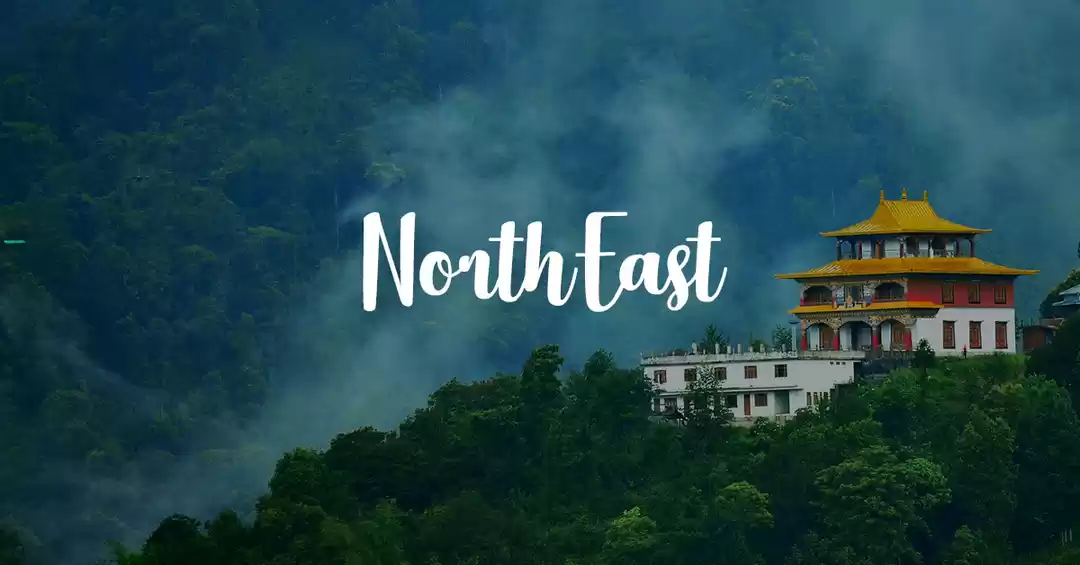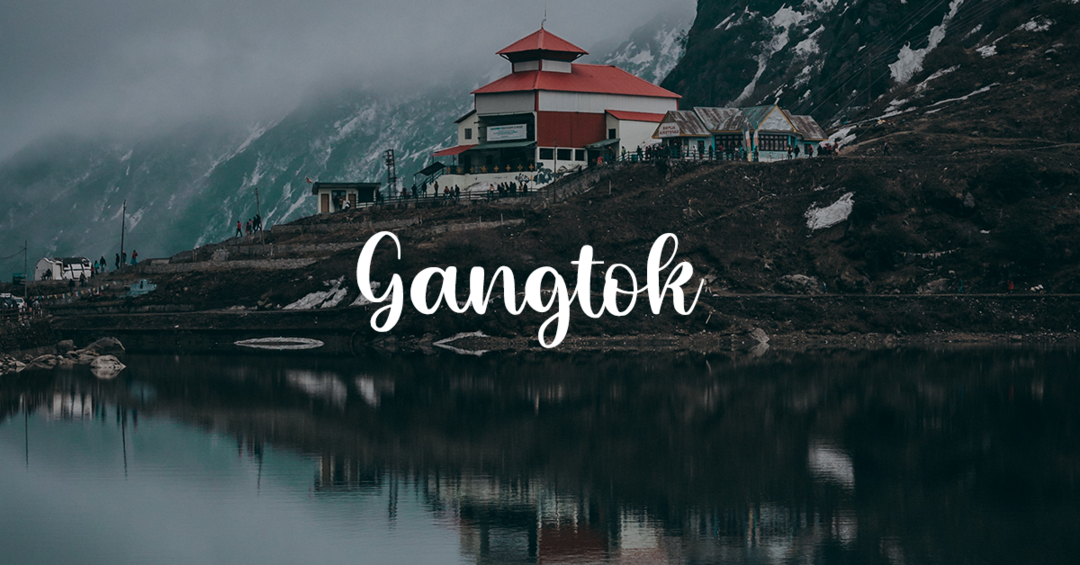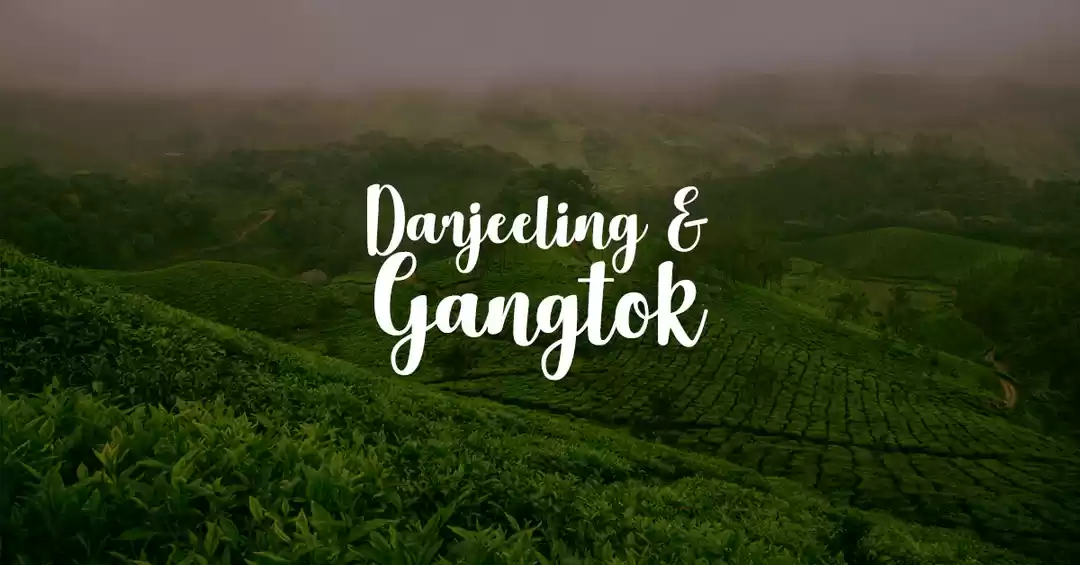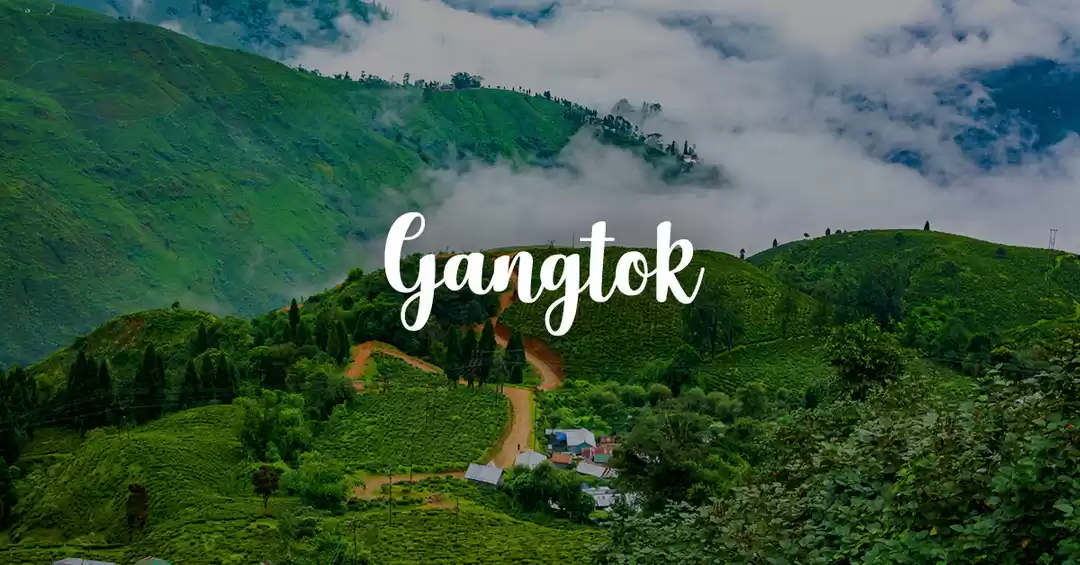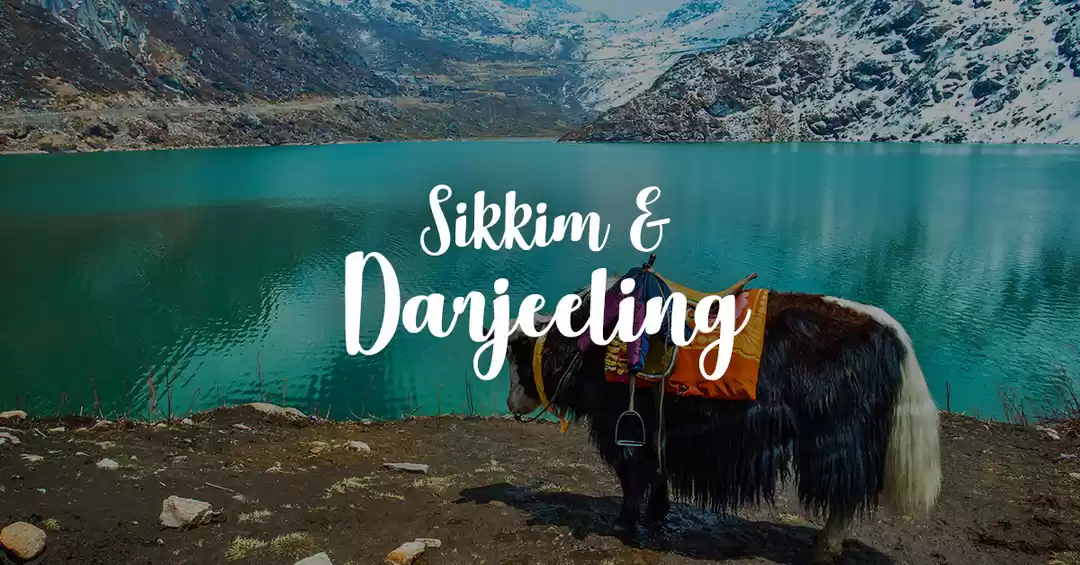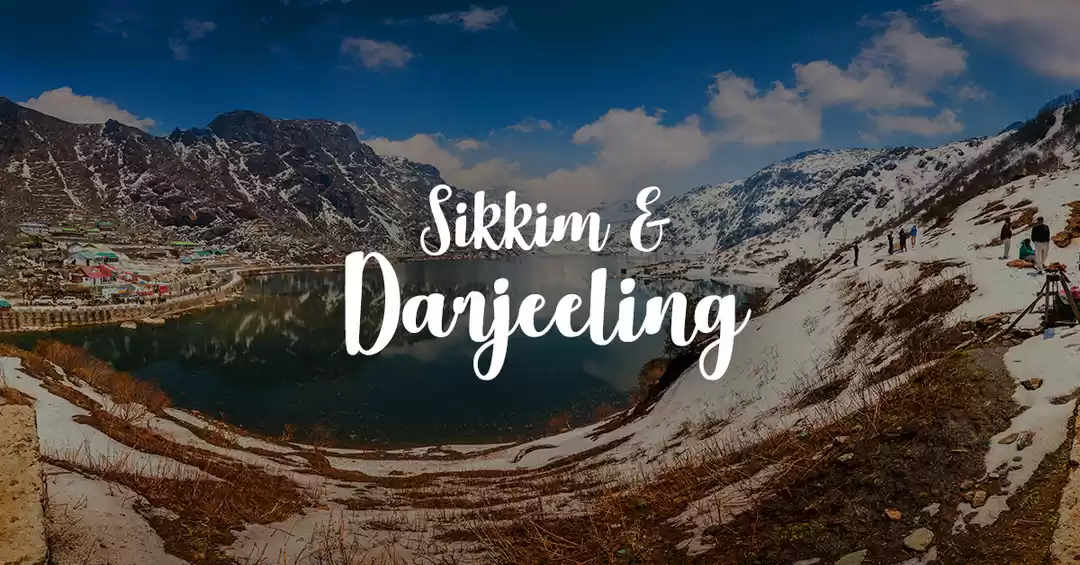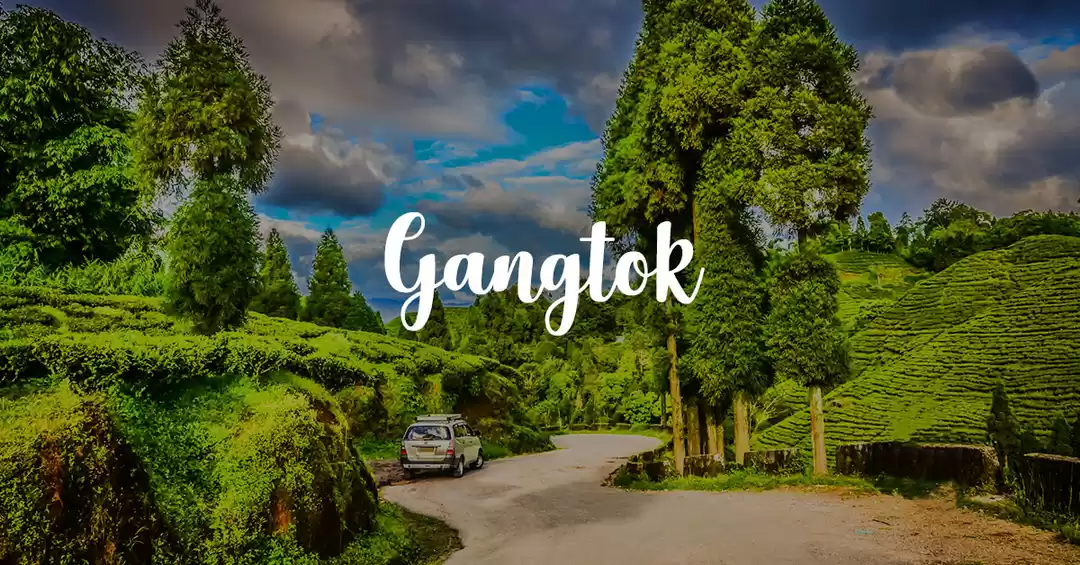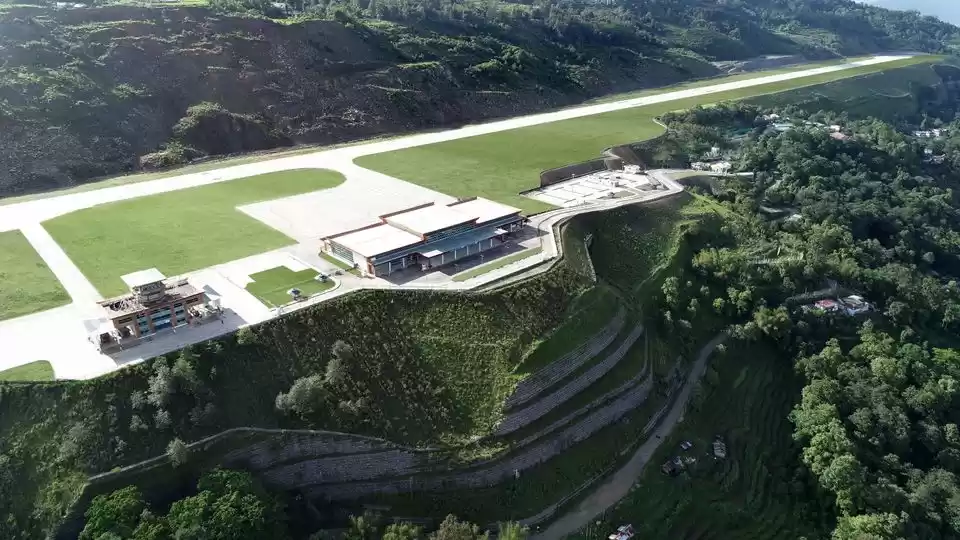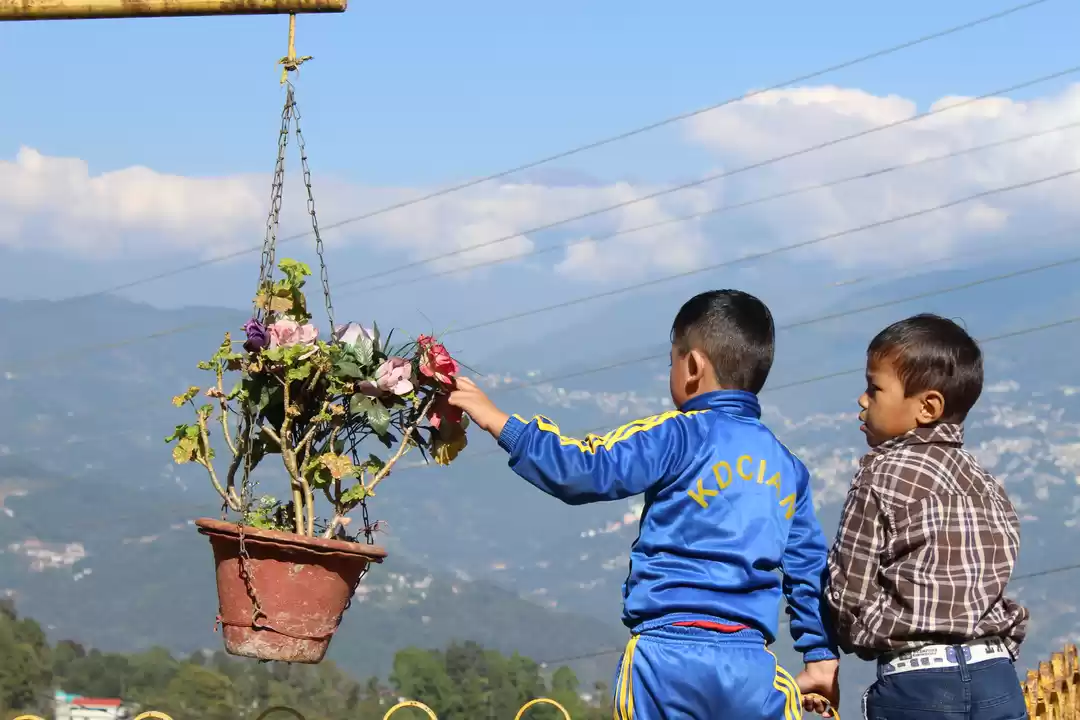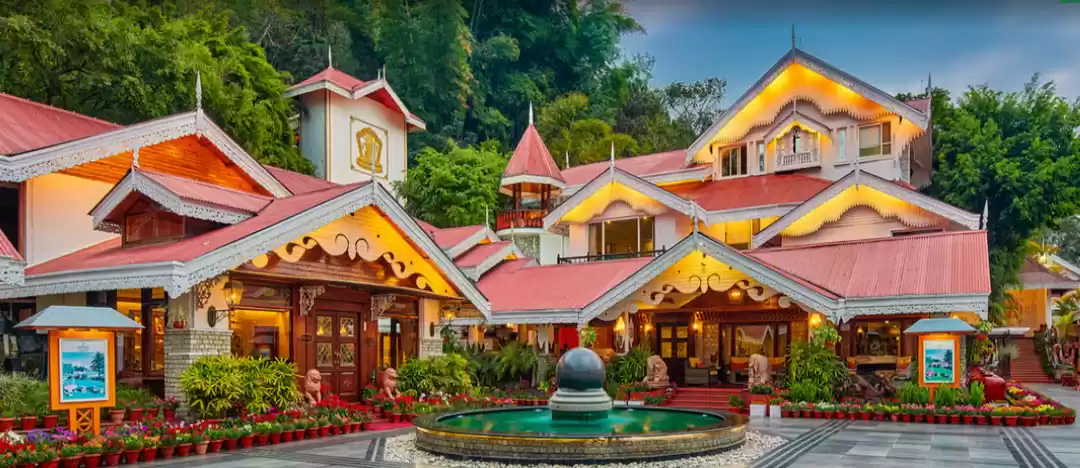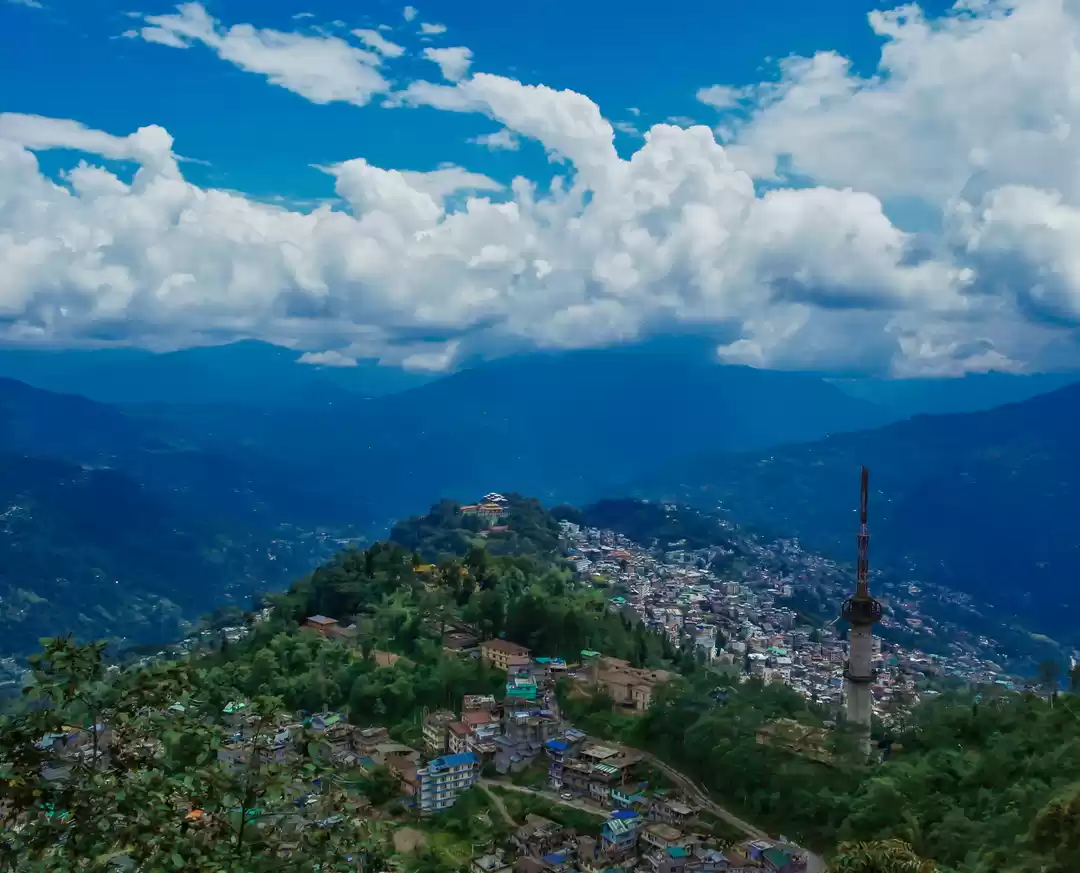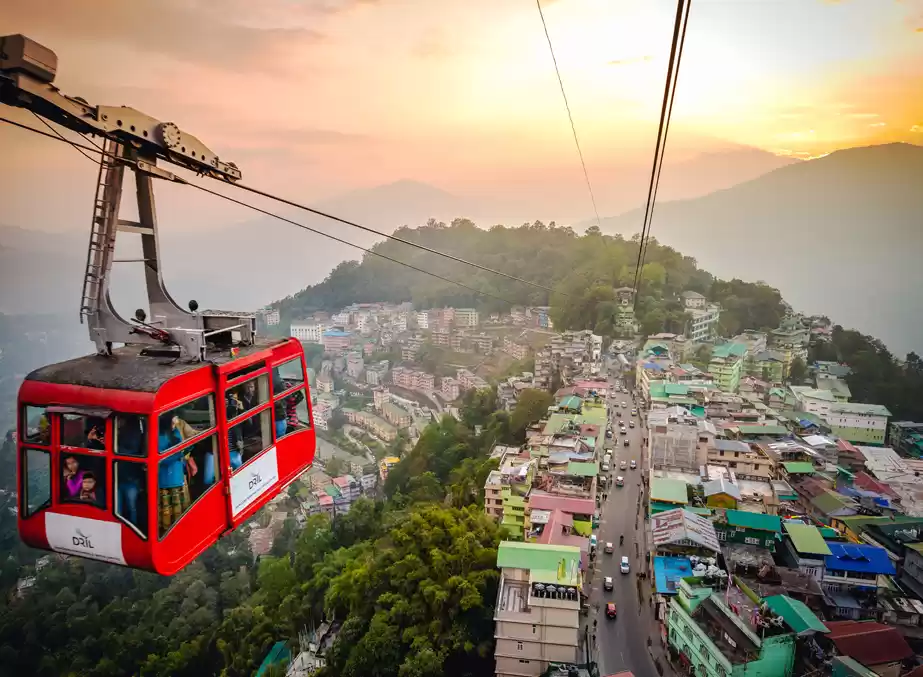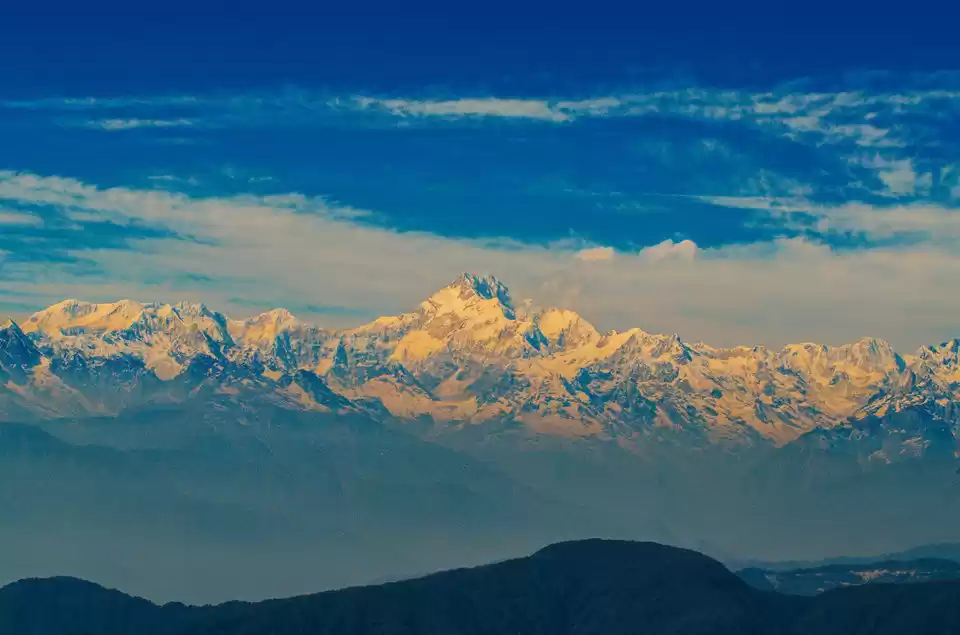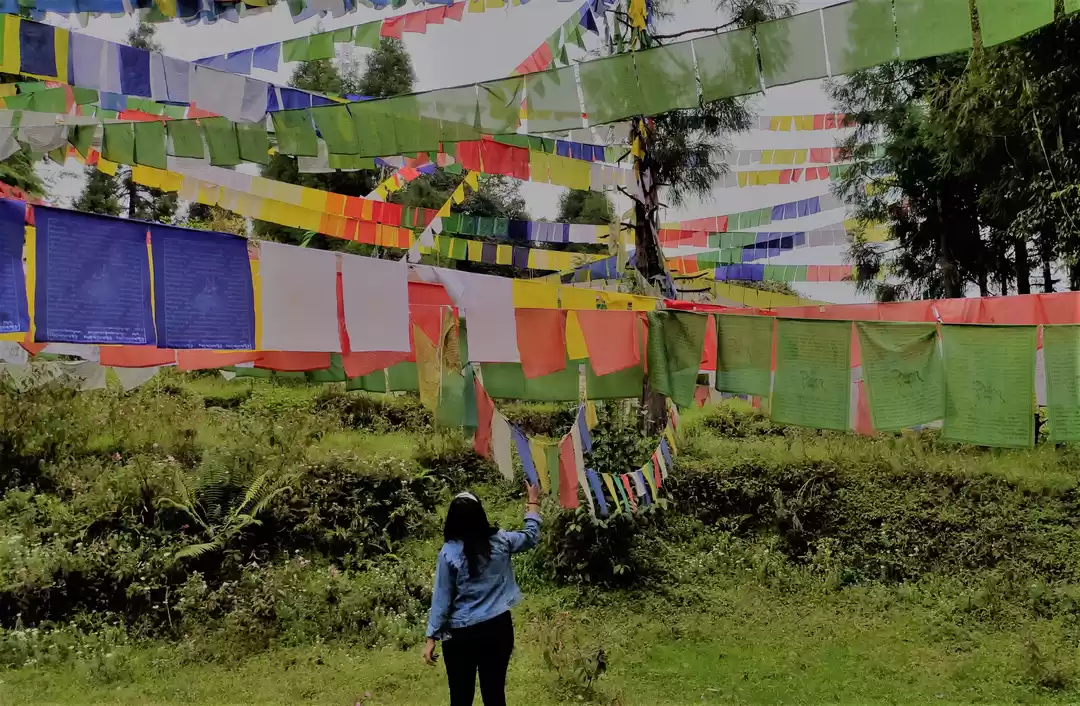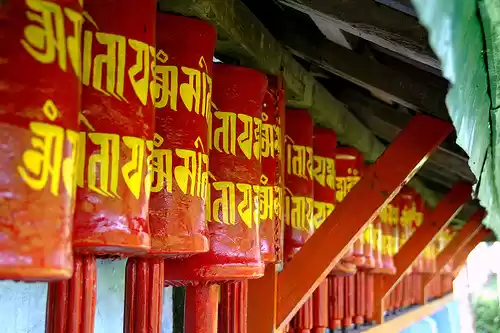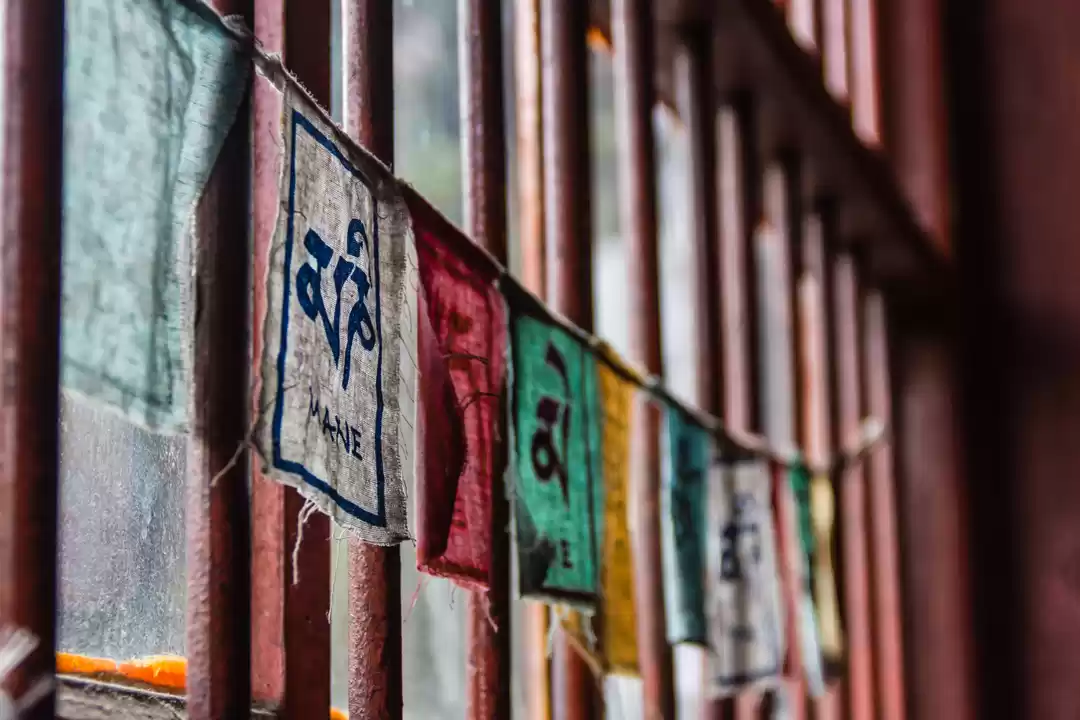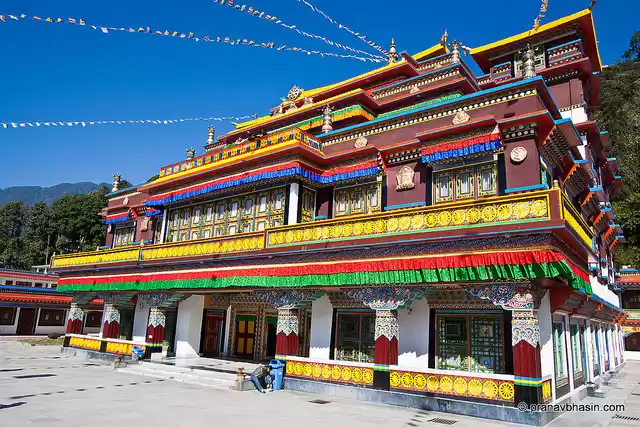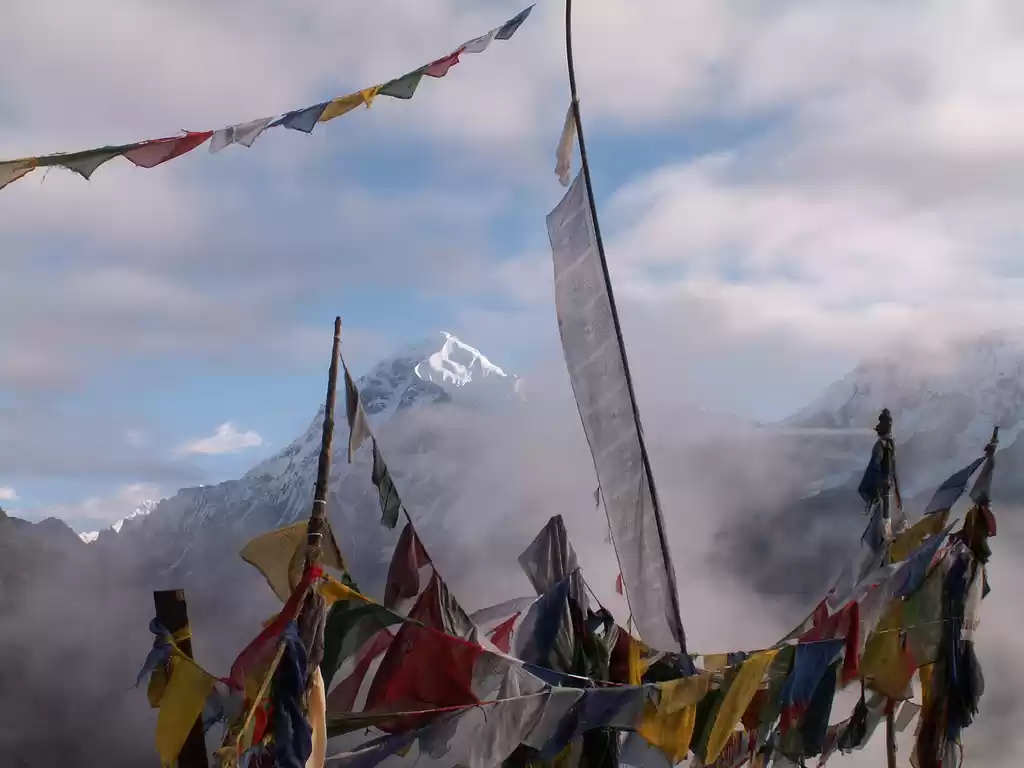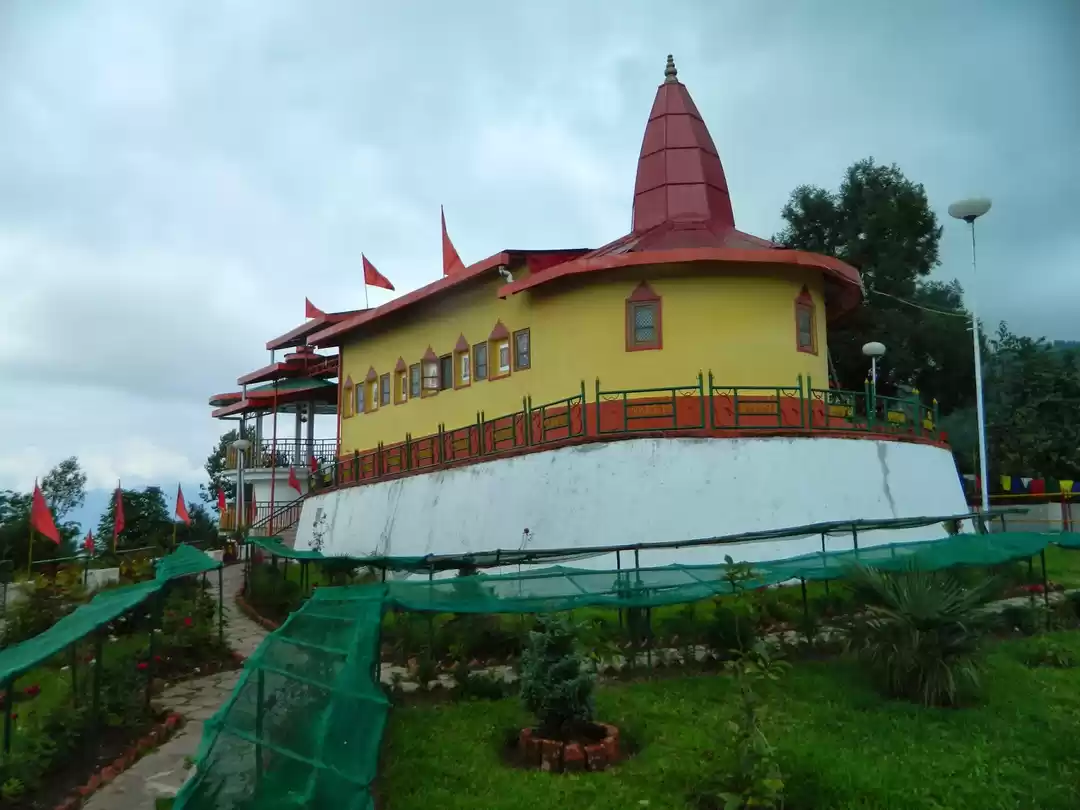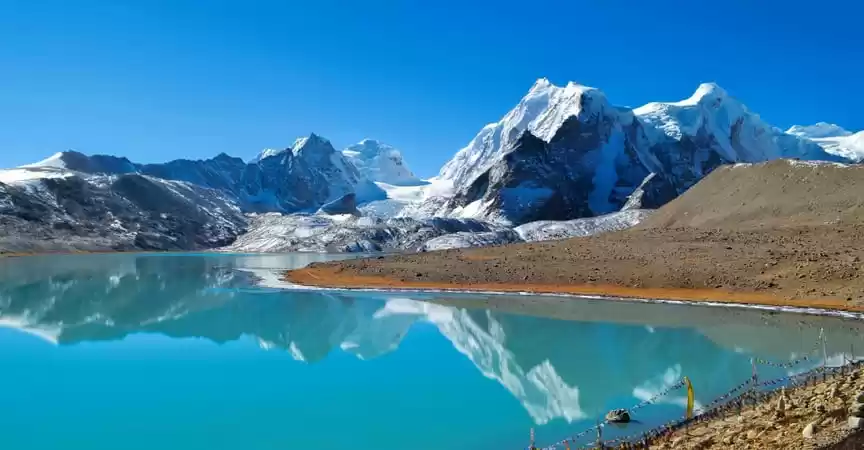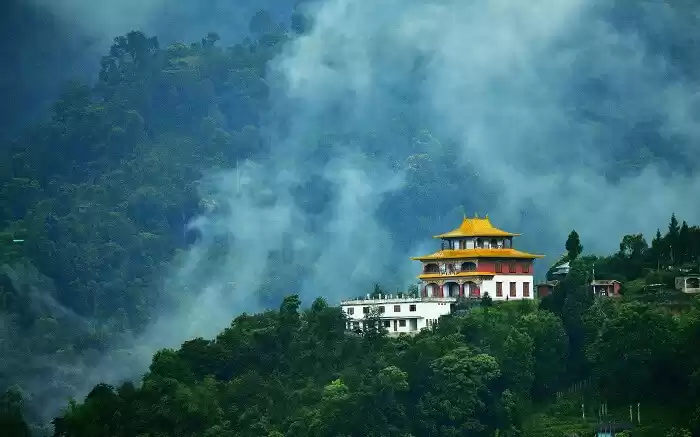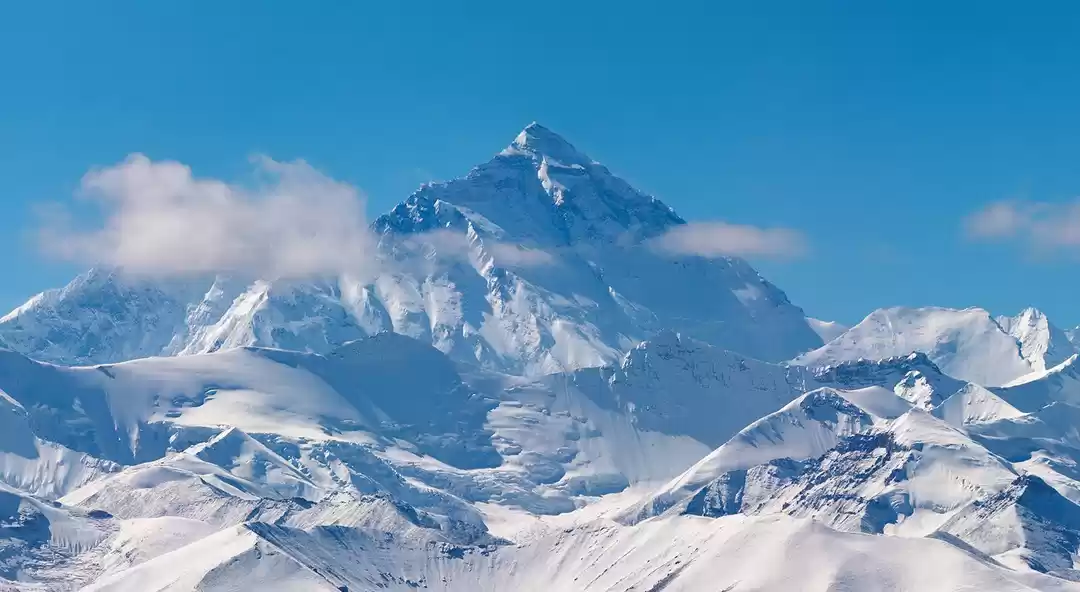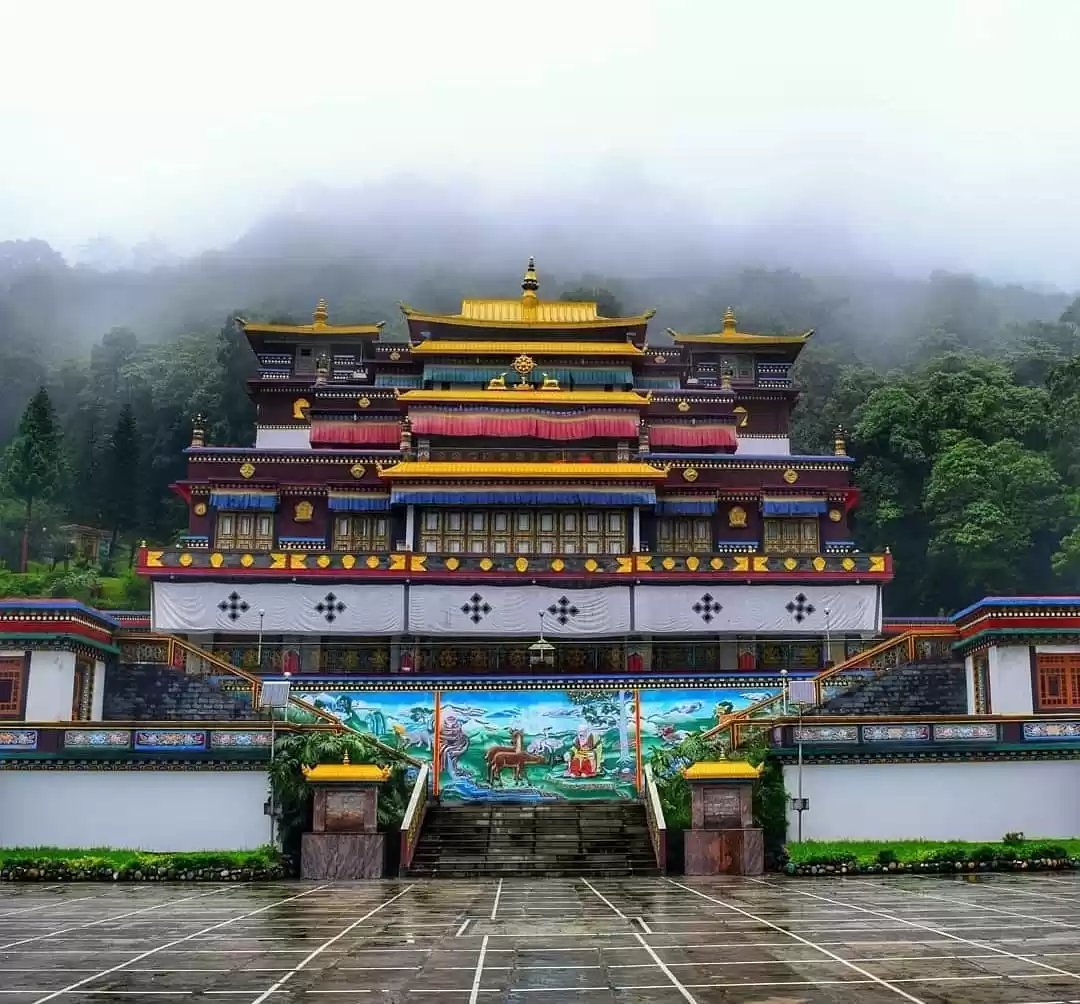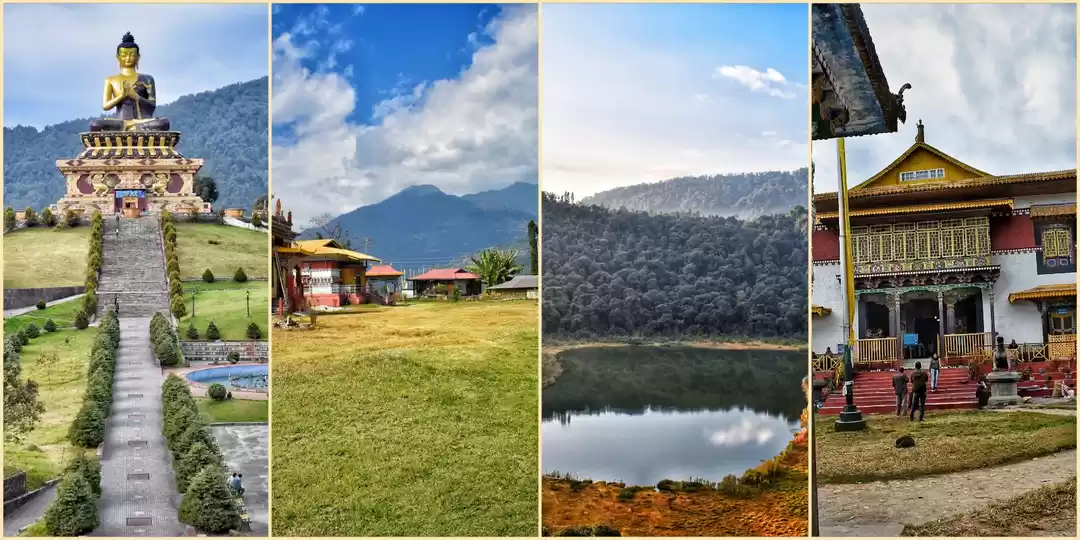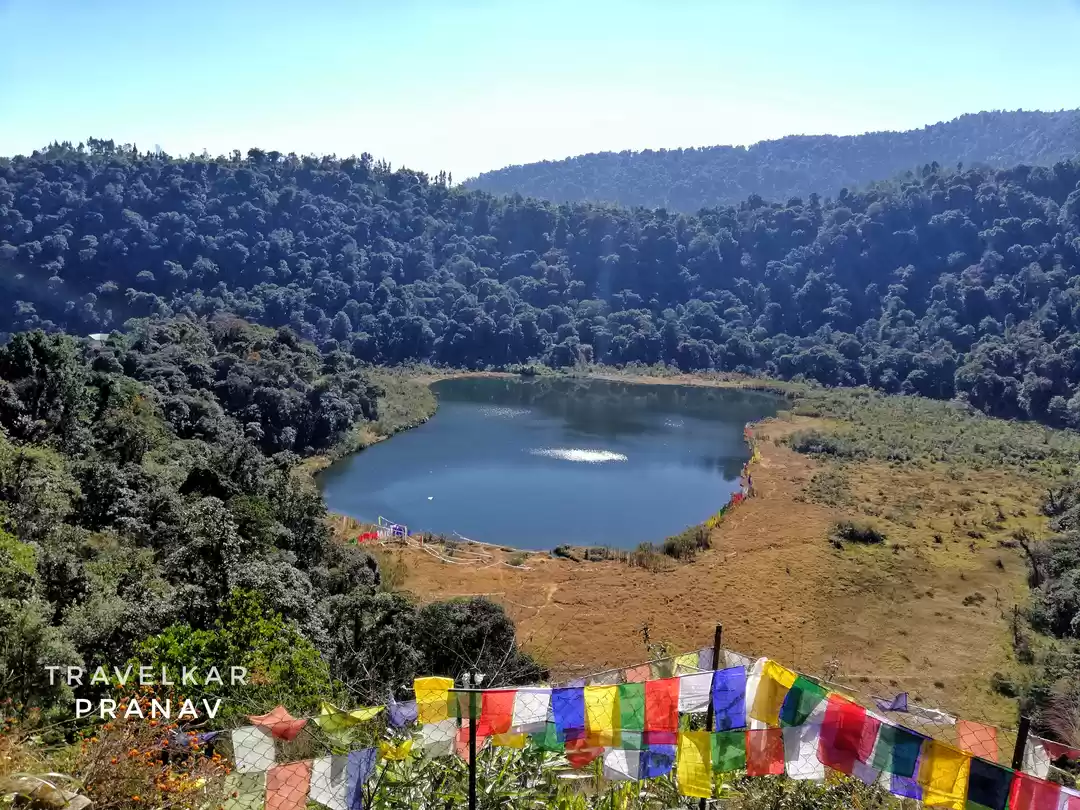
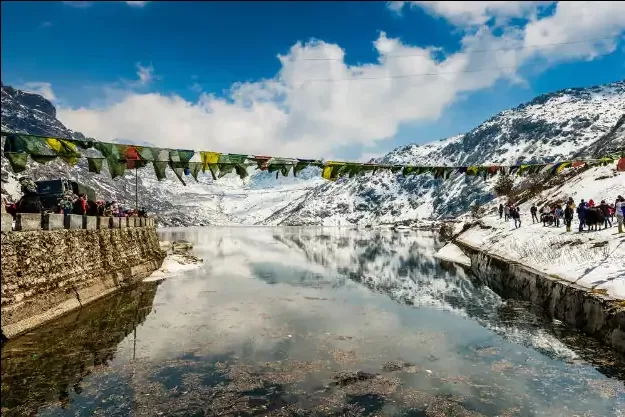
Sikkim is one of the most wonderful places to visit in India. It is arguably India’s most underrated state when it comes to tourism. Located in the beautiful north-eastern region of India, Sikkim is landlocked with Nepal to its west, the Chinese Tibet Autonomous region to its north and east, Bhutan to its east and West Bengal to its south. While Sikkim is full of stunning places to visit, its most prized possession is the amazing city of Gangtok. Capital of Sikkim, Gangtok is a hill resort and one of the most popular places in north-east India. It is known for its scenic beauty and striking views of Mount Kanchenjunga, the third highest peak in the world. Gangtok is nestled within higher Himalayan peaks with a year-round mild weather making it an excellent holiday spot. Located in the eastern Himalayan range, at an elevation of 1,650 m (5,410 ft), Gangtok houses people of different ethnicity such as Nepali, Lepchas and Bhutia. Tourism, which peaks in spring and summer, is the main source of income in Gangtok since it serves as a gateway to Sikkim. ALSO SEE 9 things about Sikkim nobody tells you Located right in the middle of the Himalayan range, Gangtok is one of the most picturesque places to visit in the whole of India. It presents the perfect image of India’s great and varied topography. This hold true to most parts of Sikkim. Despite being the least populous state in India and the second smallest state after Goa, Sikkim is still an excellent tourist spot thanks to places like Gangtok with their stunning location and amazing geographical terrain. gangtok1 Gangtok’s early history is a bit of a mystery. The earliest records date back to the year 1716 when the hermetic Gangtok monastery was constructed. Gangtok remained a small hamlet until the Enchey Monastery was constructed here in 1840. This transformed Gangtok into a major pilgrimage center. Then, in the mid-19th century, Gangtok became the capital of the state after an English conquest in response to a hostage crisis. The Tibetans were defeated by the British making Gangtok a major stopover in the trade between Tibet and British India by the end of 19th century. It was during this era that most of the roads and telegraph in the region were built.
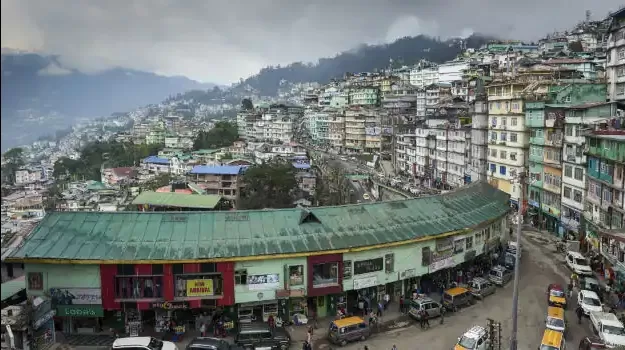
Sikkim became a suzerain of India, with the condition that it would retain its independence, in accordance with the treaty signed between the Chogyal and the Indian Prime Minister Jawaharlal Nehru. Indians gained control of external affairs on behalf of the SIkkimese thanks to this pact. Trade between India and Tibet flourished through the Nathula and Jelepla passes, which were nothing but offshoots of the ancient Silk Road near Gangtok. But then after the Sino-Indian War in 1962, which deprived Gangtok of its trading business, these prominent border passes were sealed off. Finally, in 2006, Nathu La was opened for limited trade giving hope to chances of an economic boom. In 1975, after years of turmoil, Sikkim became India’s twenty-second state, and Gangtok was chosen as its capital after a referendum.

Today, Gangtok is a cosmopolitan city with all kinds of modern amenities one would like. It has a vibrant nightlife and several nightclubs, restaurants, shopping complexes, pool parlours. Also, with the presence of so many monasteries, religious educational institutions, and Tibetology centres, Gangtok has emerged as a major centre of Tibetan Buddhist culture and learning. One of the things that make Gangtok such an alluring holiday spot is its geography. It is located in the lower Himalayas at a height of 1,650 m making it a cool destination. It lies on one side of a hill with a promendade named The Ridge which houses the governor’s residence (Raj Bhawan) at one end and a palace at the other. On the east and west, Gangtok has two streams, Roro Chu and Ranikhola, respectively which divide the drainage into eastern and western portions. These streams eventually join the Teesta at Singtam. Gangtok, much like other hilly regions like Himachal Pradesh and Uttarakhand, has extremely steep roads with houses built on compacted ground along them. Gangtok is a landslide prone region due to the underlying Precambrian rocks containing foliated phyllites and schists. Natural streams that lead to surface runoff of water and man-made drains have further contributed to the risk of landslides. Gangtok falls under the seismic zone-IV near the Indian and Eurasian tectonic plate boundary according to the Bureau of Indian Standards. This means that the region is subject to frequent earthquakes. Due to its location, you can see snow-clad Himalayan ranges towering over Gangtok from the distance. World’s third highest peak, Mount Kanchenjunga (8,598 m), can be seen to the west of the city. While the landslide vulnerability and large forest cover leading to inaccessibility of many regions have been a hindrance in the growth of this region, it has continued to bring in visitors from all across the globe due to its natural beauty. Gangtok is surrounded by dense forests which are full of poplar, oak and elm trees. From coniferous green trees of the wet alpine zone to rare orchids and bamboos, this region has it all. You will also see flowers such as sunflower, marigold, and poinsettia in full bloom between November and December. Gangtok takes its tourism very seriously. The growth in this state has been slow and so it relies heavily on tourists for its income. Strict rules have been laid down to make sure that visitors feel safe and are not cheated with unreasonable cab fares. It is also one of the cleanest cities you will ever come across. Theseasons of summer and spring are the most popular for tourists. The people of Gangtok are friendly and helpful to visitors as many of the local residents here rely on toyurism for their bread and butter. May residents are employed directly or indirectly in the Tourism industry. Several people own, co-own or work in hotels and restaurants here. The MG Marg (Road) is one of the most happening places in the city and its main shopping and cultural hub. Over the past few years, ecotourism has emerged as an important aspect of Sikkim tourism. It includes activities like trekking, mountaineering, and river rafting. Close to half a million tourists visit Sikkim every year generating sizeable revenue for the state and Gangtok is right at the forefront of Sikkim’s tourism sector.
Located right in the middle of the Himalayan range, Gangtok is one of the most picturesque places to visit in the whole of India. It presents the perfect image of India’s great and varied topography. This hold true to most parts of Sikkim. Despite being the least populous state in India and the second smallest state after Goa, Sikkim is still an excellent tourist spot thanks to places like Gangtok with their stunning location and amazing geographical terrain.
gangtok1
Gangtok’s early history is a bit of a mystery. The earliest records date back to the year 1716 when the hermetic Gangtok monastery was constructed. Gangtok remained a small hamlet until the Enchey Monastery was constructed here in 1840. This transformed Gangtok into a major pilgrimage center. Then, in the mid-19th century, Gangtok became the capital of the state after an English conquest in response to a hostage crisis. The Tibetans were defeated by the British making Gangtok a major stopover in the trade between Tibet and British India by the end of 19th century. It was during this era that most of the roads and telegraph in the region were built. ALSO READ 4-day Sikkim itinerary: Best places to visit in Sikkim!
Sikkim became a suzerain of India, with the condition that it would retain its independence, in accordance with the treaty signed between the Chogyal and the Indian Prime Minister Jawaharlal Nehru. Indians gained control of external affairs on behalf of the SIkkimese thanks to this pact. Trade between India and Tibet flourished through the Nathula and Jelepla passes, which were nothing but offshoots of the ancient Silk Road near Gangtok. But then after the Sino-Indian War in 1962, which deprived Gangtok of its trading business, these prominent border passes were sealed off. Finally, in 2006, Nathu La was opened for limited trade giving hope to chances of an economic boom. In 1975, after years of turmoil, Sikkim became India’s twenty-second state, and Gangtok was chosen as its capital after a referendum.
Gangtok
Today, Gangtok is a cosmopolitan city with all kinds of modern amenities one would like. It has a vibrant nightlife and several nightclubs, restaurants, shopping complexes, pool parlours. Also, with the presence of so many monasteries, religious educational institutions, and Tibetology centres, Gangtok has emerged as a major centre of Tibetan Buddhist culture and learning.
One of the things that make Gangtok such an alluring holiday spot is its geography. It is located in the lower Himalayas at a height of 1,650 m making it a cool destination. It lies on one side of a hill with a promendade named The Ridge which houses the governor’s residence (Raj Bhawan) at one end and a palace at the other. On the east and west, Gangtok has two streams, Roro Chu and Ranikhola, respectively which divide the drainage into eastern and western portions. These streams eventually join the Teesta at Singtam. Gangtok, much like other hilly regions like Himachal Pradesh and Uttarakhand, has extremely steep roads with houses built on compacted ground along them.
Gangtok is a landslide prone region due to the underlying Precambrian rocks containing foliated phyllites and schists. Natural streams that lead to surface runoff of water and man-made drains have further contributed to the risk of landslides. Gangtok falls under the seismic zone-IV near the Indian and Eurasian tectonic plate boundary according to the Bureau of Indian Standards. This means that the region is subject to frequent earthquakes. Due to its location, you can see snow-clad Himalayan ranges towering over Gangtok from the distance. World’s third highest peak, Mount Kanchenjunga (8,598 m), can be seen to the west of the city. While the landslide vulnerability and large forest cover leading to inaccessibility of many regions have been a hindrance in the growth of this region, it has continued to bring in visitors from all across the globe due to its natural beauty.
Gangtok is surrounded by dense forests which are full of poplar, oak and elm trees. From coniferous green trees of the wet alpine zone to rare orchids and bamboos, this region has it all. You will also see flowers such as sunflower, marigold, and poinsettia in full bloom between November and December.
Gangtok takes its tourism very seriously. The growth in this state has been slow and so it relies heavily on tourists for its income. Strict rules have been laid down to make sure that visitors feel safe and are not cheated with unreasonable cab fares. It is also one of the cleanest cities you will ever come across. Theseasons of summer and spring are the most popular for tourists. The people of Gangtok are friendly and helpful to visitors as many of the local residents here rely on toyurism for their bread and butter. May residents are employed directly or indirectly in the Tourism industry. Several people own, co-own or work in hotels and restaurants here. The MG Marg (Road) is one of the most happening places in the city and its main shopping and cultural hub. Over the past few years, ecotourism has emerged as an important aspect of Sikkim tourism. It includes activities like trekking, mountaineering, and river rafting. Close to half a million tourists visit Sikkim every year generating sizeable revenue for the state and Gangtok is right at the forefront of Sikkim’s tourism sector.
GETTING TO GANGTOK
Gangtok does not have an airport of its own but is located at a convenient distance of 124 km from the Bagdodara airport. This airport is connected to Kolkata, Delhi and Guwahati. For international travellers, the best thing to do is take a flight to Delhi or Kolkata and then take a connecting flight or reach Gangtok by road. You can hire a taxi from Bagdogra Airport’s pre-paid taxi counter to reach Gangtok. It will cost you around Rs 2000 to 4000 depending upon the vehicle you choose. You can also take a shared cab up to Siliguri and then another cab from there to Sikkim. Helicopter services are also available from Bagdodara to Gangtok but only once during the day.
The nearest railhead to reach Gangtok is New Jalpaiguri which is located 148 km from Gangtok. Gangtok has well-maintained roads to New Jalpaiguri. All trains that leave Guwahati for the rest of the country pass through New jalpaiguri which means that it is connected to big cities like New Delhi, Kolkata, Chennai, Mumbai, Bangalore, Ahmedabad, Jodhpur, Chandigarh, Pune, Amritsar and many more.
Gangtok is well-connected by road to all major cities around like Kolkata, Delhi and other places in Sikkim. Buses are available to Gangtok from major nearby cities. Those coming by train to New Jalpaiguri can either opt for a taxi, an auto-rickshaw or a bus to reach the Siliguri bus stand from where you have many bus options to reach Gangtok. It’s a 4-hour journey and costs around Rs 135 per head in a Sikkim National Transport bus. You can also take a seat in one of the several sumos or jeeps that play between SIliguri and Gangtok. It costs around Rs 200 per head but is much faster than the buses. It is best to avoid the tour packages that are offered at New Jalpaiguri station as their standards are not very good.
When it comes to travelling within the city, there are taxi stands after every km and you can take share taxis to go from one point to another. Small distances cost around Rs15-20 per head while the fare for long distances will depend upon the distance. Usually, a typical shared taxi fare is around Rs 150 for a long trip.
WHAT TO SEE IN SIKKIM
Sikkim is full of marvels for those who love nature and adventure. It is one of the lesser-explored and therefore lesser-polluted places of India. Gangtok, being Sikkim’s capital and most prominent tourist attraction, has loads to offer to tourists. Be it unparalleled natural beauty or an adrenaline rush through adventure activities Gangtok has several options for whatever visitors are looking for. Gangtok is also known as the land of monasteries due to the sheer number of monasteries it houses. It has emerged as a major Buddhist pilgrimage center and has some of the finest monasteries in India that you cannot afford to miss.
The Rumtek monastery is undoubtedly one of the greatest monasteries in the country. It is Sikkim’as largest monastery and is renowned all over India as it is the seat of Karmapa Lama, the thirds highest monk in Tibetan Buddhism. It also serves as a prominent seat of another sect of Tibetan Buddhism called Kagyu or Dharmachakra centre. Rumtek monastery is located about 23 km from Gangtok. It was built by the 4th King of Sikkim as the ninth Karmapa (head of the Karma Kagyu sect) supervised the construction. The Rumtek monastery is located at an elevation of around 5000 ft with lush green landscapes all around it. The monastery not only provides spectacular views but also spiritual peace. The architectural design is known to be identical to the original Kagyu headquarters in Tibet. The Kagyu (also known as Kagyupa or Kagyud) school is one of six primary schools of Tibetan Buddhism. It is believed that when the first Karmapa meditated for many years in a cave, ten thousand fairies, impressed with his feat, offered him a strand of hair each. These strands of hair were woven into a black hat which was passed over the generations and still remains in the Rumtek Monastery. This hat is always kept in a box or held by hand or it is believed to fly away. The Karmapas wear the hat during ceremonies. There is a golden stupa in the monastery which contains relics like statues and paintings belonging to the 16th Karmapa. After China annexed Tibet, the Rumtek monastery grew into prominence and many religious gurus relocated from Tibet to Sikkim. Today, the monastery houses several religious art objects and some of the world’s most unique religious scriptures. Foreign nationals need to obtain a permit from the main government office at Sikkim and Siliguri to visit the Rumtek monastery. Accommodation options near the monastery are limited but you can several options for all budgest are available at Gangtok. It is advisable to carry your own food and water while visiting the monastery. Shambala Mountain Resort and Martam Village Resort located near the monastery have decent restaurants.The best time to visit the RUmtek monastery is between September and June.
Apart from Rumtek itself, there are several other plces to visit near the monastery. The Nalanda Institute of Higher Buddhist Studies is located nearby. Less than a kilometre uphill from the monastery is a serene hermitage where monks meditate for years. When you walk downhill from the main monastery, you can see the site of the old monastery which was destroyed in a fire and restored later.
Kalimpong is located around 75 km south-west of the Rumtek monastery. It is a pleasant hill station with some beautiful ancient Buddhist monasteries, quaint old churches and famous temples.
Just 100 km southwest of Rumtek is the lovely and hugely popular hill station of Darjeeling. It is located at an elevation of over 7000 ft amidst the backdrop of the snow-clad Himalayan peaks. The world’s third-highest peak, Kanchenjunga, can be seen from here when it is not too cloudy.
Another spectacular monastery is the Pemayangtse monastery. The second oldest monastery in Sikkim, Pemayangtse is located at a height of 5840 ft and falls about 107 km west of Gangtok. This is another monastery where you can see the spectacular view of snow-capped mountains and valleys with dense forests. Literally meaning ‘perfect sublime lotus’, the world pemayangtse is believed to symbolize one of the four retes or network of cells in the human body. Pemayangtse Monastery has emerged as one of the main tourist attractions of the town. Despite being over 300 years old, the monastery has been maintained extremely well by the monks and continues to be in excellent condition. The monastery has a three-storied structure. Several statues have been placed in the monastery including those of Padmasambhava. Pemayangtse has quite an intriguing history behind its construction. It is believed to have been designed and founded by Lama Lhatsun Chempoway. It was originally built as a crypt and expanded later. The infamous earthquakes of 1913 and 1960 ruined the whole town including the monaster. However, the monastery was rebuilt and has been renovated many times since. The monks residing in the monastery are sworn to celibacy. These monks hold the title ‘ta-tshang’. When you enter the first floor of the monastery, you will see several amazing paintings and ancient scrolls and some beautiful sculptures. A notable statue of Padmasambhava’s eight incarnations is one of the most special statues here. It has a seven layered wooden structure depicting the heavenly abode of Guru Rimpoche. When you enter the main prayer hall of the monastery, you can see some exquisitely carved statues near the entrance which display meticulous attention to detail. There is also an extremely well-maintained and beautiful garden adjacent to the monastery. The best time to visit the Pemayangtse monastery is during the Cham dance festival. During this event, you can witness the lamas of the monastery dressing up in colourful costumes and performing traditional dances.
Not very far away from Pemayangtse monastery are some other amazing spots worth visiting. The monastery serves as the starting point of the famous Dzongri trekking trail which takes you through the dense forests in Khangchendzonga National Park. This 46 km long trekking trail is a delight for adventure enthusiasts as it is considered to be the most popular trail in Sikkim.
Another excellent place worth visiting is the ruins of Rabdentse. Rabdentse is famous for being the erstwhile royal capital of Sikkim. It is located around 107 km west of Gangtok, ans was first established way back in 1670 by Chadok Namgyal. The primary capital Yuksom came to be declared as sacred in 1642 as a result of which the capital was shifted to Rabdentse. The Nepalese Army destroyed the city almost completely leaving only the chortens and ruins of the palace. Recent excavations and restorations by the Archaeological Society of India have been successful in recreating several parts of the palace like the king’s bedroom, kitchen, assembly hall, public courtyard and guards’ rooms. These ruins have aptly been declared as a monument of national importance. The ruins are located in the district of West Sikkim, and lie on a ridge providing unparalleled panoramic views of the dense forest and snow-capped mountain peaks. Rabdentse ruins can be reach from Pelling by trekking just for two hours. There is also a bird park nearby which is popular with tourists. A visit to the ruins is perfect for history buffs who like going back in time. The way to Rabdentse is quite spectacular too as it is dotted with dense forests, beautiful lakes, and rare orchids. The ruins of the city include three standing stones called Namphogang. It is believed that these stone thrones were seats of judges during the glorious days of the city. The palatial ruins offer a splendid panoramic view of the entire south-west Sikkim. The ‘Dab Lhagang’ is another prominent place right next to the ruins. It is where members of the royal family are believed to have offered prayers to their gods. The Rabdenstse ruins form part of the Buddhist pilgrimage beginning from Yuksom at Dubdi Monastery, and then through Norbugang Chorten, Tashiding Monastery, Pemayangtse Monastery, Sangachoeling Monastery ending at the Khecheopalri Lake. It is a rewarding experience for anyone to be part of this
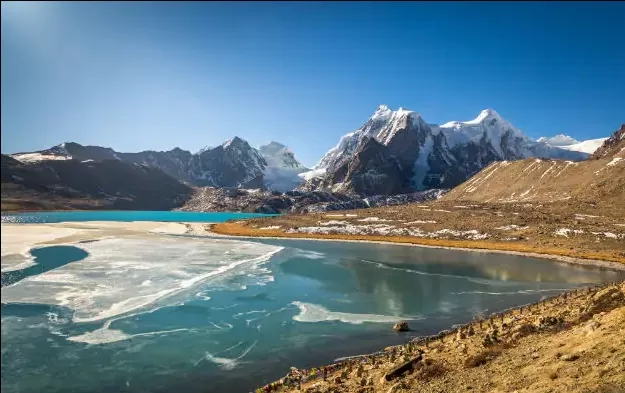
Gurudongmar Lake is one of the most amazing lakes in India. Located at 17,100 ft, Gurudongmar Lake is renowned as one of the highest altitude lakes in the world and is just 5 m south of the Chinese border. It is one of the frozen lakes of India during winter months of November to May. It gives water to the river Teesta along with the Pauhunri and Zemu glaciers and the beautiful Chomalu lake. The lake is considered a sacred spot for Buddhist and Sikhs. It is believed that this lake was blessed by the Buddhist Guru Padmasambava who is renowned as Guru Rinpoche, the revered founder of Tibetan Buddhism. The story goes that he touched the frozen lake at a point to make sure the villagers receive drinking water through that portion. It is said that the portion he touched does not freeze till date no matter how much the temperature falls. Another legend goes that the lake was blessed by the Sikh Guru Nanak on his visit to Sikkim. There are several beliefs surrounding the Gurudongmar lake. One such belief is that the lake grants wishes to pregnant women who pay it a visit. Sarva Dharma Stala is a prayer spot near the lake which has become a major attraction for people of all religions. While visiting Gurudingmr, it is best to stay at Lachen as it is better-connected to the rest of Sikkim. Gurudongmar does have its share of comfortable hotels but there are not many eateries here and you would need to make do with basic amenities and simple food. It is advisable to carry your own snacks to this high-altitude lake. You will find some local food options near Mangan where you can try out delicious momos. Your trip to Gurudingmar lake can be combined with a visit to Lachen, Lachung and Yumthang valley. They are at gradually increasing distances from Gurudingmar with Lachen being the closest (3 hours). Lachen is known for its rich wildlife and fantastic trekking options like Gurudongmar and Chopta valley. The Lachen gompa is a popular attraction amongst those who visit this region. Be advised that foreigners need special permission to enter Lachen. And then there is Lachung, a high-altitude town located around 125 km from the state capital Gangtok. It is known mainly for its mesmerizing mountain peaks covered in snow. The natural beauty in this place is absolutely spell binding and difficult to describe in words. However, it’s not just the natural beauty that draws visitors to Lachung. It also offers some amazing adventure activities like skiing and trekking. The Laching Gompa must not be missed if you go all the way here. Its ancient inscriptions are totally worth checking out.
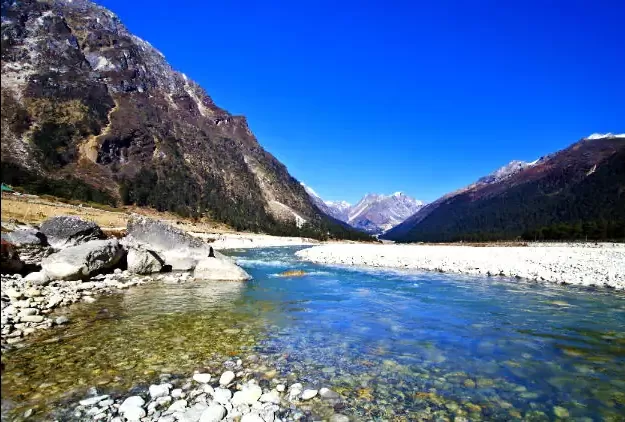
TRAVEL HOMEDESTINATIONSWEEKEND GETAWAYSEXPLOREARTICLES Advertisement HomeTravelDestinations Gangtok Places to visit Things to do How to reach Articles Photos Map GANGTOK TOURISM Sikkim is one of the most wonderful places to visit in India. It is arguably India’s most underrated state when it comes to tourism. Located in the beautiful north-eastern region of India, Sikkim is landlocked with Nepal to its west, the Chinese Tibet Autonomous region to its north and east, Bhutan to its east and West Bengal to its south. While Sikkim is full of stunning places to visit, its most prized possession is the amazing city of Gangtok. Capital of Sikkim, Gangtok is a hill resort and one of the most popular places in north-east India. It is known for its scenic beauty and striking views of Mount Kanchenjunga, the third highest peak in the world. Gangtok is nestled within higher Himalayan peaks with a year-round mild weather making it an excellent holiday spot. Located in the eastern Himalayan range, at an elevation of 1,650 m (5,410 ft), Gangtok houses people of different ethnicity such as Nepali, Lepchas and Bhutia. Tourism, which peaks in spring and summer, is the main source of income in Gangtok since it serves as a gateway to Sikkim. ALSO SEE 9 things about Sikkim nobody tells you Located right in the middle of the Himalayan range, Gangtok is one of the most picturesque places to visit in the whole of India. It presents the perfect image of India’s great and varied topography. This hold true to most parts of Sikkim. Despite being the least populous state in India and the second smallest state after Goa, Sikkim is still an excellent tourist spot thanks to places like Gangtok with their stunning location and amazing geographical terrain. Gangtok’s early history is a bit of a mystery. The earliest records date back to the year 1716 when the hermetic Gangtok monastery was constructed. Gangtok remained a small hamlet until the Enchey Monastery was constructed here in 1840. This transformed Gangtok into a major pilgrimage center. Then, in the mid-19th century, Gangtok became the capital of the state after an English conquest in response to a hostage crisis. The Tibetans were defeated by the British making Gangtok a major stopover in the trade between Tibet and British India by the end of 19th century. It was during this era that most of the roads and telegraph in the region were built. ALSO READ 4-day Sikkim itinerary: Best places to visit in Sikkim! Sikkim became a suzerain of India, with the condition that it would retain its independence, in accordance with the treaty signed between the Chogyal and the Indian Prime Minister Jawaharlal Nehru. Indians gained control of external affairs on behalf of the SIkkimese thanks to this pact. Trade between India and Tibet flourished through the Nathula and Jelepla passes, which were nothing but offshoots of the ancient Silk Road near Gangtok. But then after the Sino-Indian War in 1962, which deprived Gangtok of its trading business, these prominent border passes were sealed off. Finally, in 2006, Nathu La was opened for limited trade giving hope to chances of an economic boom. In 1975, after years of turmoil, Sikkim became India’s twenty-second state, and Gangtok was chosen as its capital after a referendum. Today, Gangtok is a cosmopolitan city with all kinds of modern amenities one would like. It has a vibrant nightlife and several nightclubs, restaurants, shopping complexes, pool parlours. Also, with the presence of so many monasteries, religious educational institutions, and Tibetology centres, Gangtok has emerged as a major centre of Tibetan Buddhist culture and learning. One of the things that make Gangtok such an alluring holiday spot is its geography. It is located in the lower Himalayas at a height of 1,650 m making it a cool destination. It lies on one side of a hill with a promendade named The Ridge which houses the governor’s residence (Raj Bhawan) at one end and a palace at the other. On the east and west, Gangtok has two streams, Roro Chu and Ranikhola, respectively which divide the drainage into eastern and western portions. These streams eventually join the Teesta at Singtam. Gangtok, much like other hilly regions like Himachal Pradesh and Uttarakhand, has extremely steep roads with houses built on compacted ground along them. Gangtok is a landslide prone region due to the underlying Precambrian rocks containing foliated phyllites and schists. Natural streams that lead to surface runoff of water and man-made drains have further contributed to the risk of landslides. Gangtok falls under the seismic zone-IV near the Indian and Eurasian tectonic plate boundary according to the Bureau of Indian Standards. This means that the region is subject to frequent earthquakes. Due to its location, you can see snow-clad Himalayan ranges towering over Gangtok from the distance. World’s third highest peak, Mount Kanchenjunga (8,598 m), can be seen to the west of the city. While the landslide vulnerability and large forest cover leading to inaccessibility of many regions have been a hindrance in the growth of this region, it has continued to bring in visitors from all across the globe due to its natural beauty. Gangtok is surrounded by dense forests which are full of poplar, oak and elm trees. From coniferous green trees of the wet alpine zone to rare orchids and bamboos, this region has it all. You will also see flowers such as sunflower, marigold, and poinsettia in full bloom between November and December. Gangtok takes its tourism very seriously. The growth in this state has been slow and so it relies heavily on tourists for its income. Strict rules have been laid down to make sure that visitors feel safe and are not cheated with unreasonable cab fares. It is also one of the cleanest cities you will ever come across. Theseasons of summer and spring are the most popular for tourists. The people of Gangtok are friendly and helpful to visitors as many of the local residents here rely on toyurism for their bread and butter. May residents are employed directly or indirectly in the Tourism industry. Several people own, co-own or work in hotels and restaurants here. The MG Marg (Road) is one of the most happening places in the city and its main shopping and cultural hub. Over the past few years, ecotourism has emerged as an important aspect of Sikkim tourism. It includes activities like trekking, mountaineering, and river rafting. Close to half a million tourists visit Sikkim every year generating sizeable revenue for the state and Gangtok is right at the forefront of Sikkim’s tourism sector. GETTING TO GANGTOK Gangtok does not have an airport of its own but is located at a convenient distance of 124 km from the Bagdodara airport. This airport is connected to Kolkata, Delhi and Guwahati. For international travellers, the best thing to do is take a flight to Delhi or Kolkata and then take a connecting flight or reach Gangtok by road. You can hire a taxi from Bagdogra Airport’s pre-paid taxi counter to reach Gangtok. It will cost you around Rs 2000 to 4000 depending upon the vehicle you choose. You can also take a shared cab up to Siliguri and then another cab from there to Sikkim. Helicopter services are also available from Bagdodara to Gangtok but only once during the day. The nearest railhead to reach Gangtok is New Jalpaiguri which is located 148 km from Gangtok. Gangtok has well-maintained roads to New Jalpaiguri. All trains that leave Guwahati for the rest of the country pass through New jalpaiguri which means that it is connected to big cities like New Delhi, Kolkata, Chennai, Mumbai, Bangalore, Ahmedabad, Jodhpur, Chandigarh, Pune, Amritsar and many more. Gangtok is well-connected by road to all major cities around like Kolkata, Delhi and other places in Sikkim. Buses are available to Gangtok from major nearby cities. Those coming by train to New Jalpaiguri can either opt for a taxi, an auto-rickshaw or a bus to reach the Siliguri bus stand from where you have many bus options to reach Gangtok. It’s a 4-hour journey and costs around Rs 135 per head in a Sikkim National Transport bus. You can also take a seat in one of the several sumos or jeeps that play between SIliguri and Gangtok. It costs around Rs 200 per head but is much faster than the buses. It is best to avoid the tour packages that are offered at New Jalpaiguri station as their standards are not very good. When it comes to travelling within the city, there are taxi stands after every km and you can take share taxis to go from one point to another. Small distances cost around Rs15-20 per head while the fare for long distances will depend upon the distance. Usually, a typical shared taxi fare is around Rs 150 for a long trip. WHAT TO SEE IN SIKKIM Sikkim is full of marvels for those who love nature and adventure. It is one of the lesser-explored and therefore lesser-polluted places of India. Gangtok, being Sikkim’s capital and most prominent tourist attraction, has loads to offer to tourists. Be it unparalleled natural beauty or an adrenaline rush through adventure activities Gangtok has several options for whatever visitors are looking for. Gangtok is also known as the land of monasteries due to the sheer number of monasteries it houses. It has emerged as a major Buddhist pilgrimage center and has some of the finest monasteries in India that you cannot afford to miss. The Rumtek monastery is undoubtedly one of the greatest monasteries in the country. It is Sikkim’as largest monastery and is renowned all over India as it is the seat of Karmapa Lama, the thirds highest monk in Tibetan Buddhism. It also serves as a prominent seat of another sect of Tibetan Buddhism called Kagyu or Dharmachakra centre. Rumtek monastery is located about 23 km from Gangtok. It was built by the 4th King of Sikkim as the ninth Karmapa (head of the Karma Kagyu sect) supervised the construction. The Rumtek monastery is located at an elevation of around 5000 ft with lush green landscapes all around it. The monastery not only provides spectacular views but also spiritual peace. The architectural design is known to be identical to the original Kagyu headquarters in Tibet. The Kagyu (also known as Kagyupa or Kagyud) school is one of six primary schools of Tibetan Buddhism. It is believed that when the first Karmapa meditated for many years in a cave, ten thousand fairies, impressed with his feat, offered him a strand of hair each. These strands of hair were woven into a black hat which was passed over the generations and still remains in the Rumtek Monastery. This hat is always kept in a box or held by hand or it is believed to fly away. The Karmapas wear the hat during ceremonies. There is a golden stupa in the monastery which contains relics like statues and paintings belonging to the 16th Karmapa. After China annexed Tibet, the Rumtek monastery grew into prominence and many religious gurus relocated from Tibet to Sikkim. Today, the monastery houses several religious art objects and some of the world’s most unique religious scriptures. Foreign nationals need to obtain a permit from the main government office at Sikkim and Siliguri to visit the Rumtek monastery. Accommodation options near the monastery are limited but you can several options for all budgest are available at Gangtok. It is advisable to carry your own food and water while visiting the monastery. Shambala Mountain Resort and Martam Village Resort located near the monastery have decent restaurants.The best time to visit the RUmtek monastery is between September and June. Apart from Rumtek itself, there are several other plces to visit near the monastery. The Nalanda Institute of Higher Buddhist Studies is located nearby. Less than a kilometre uphill from the monastery is a serene hermitage where monks meditate for years. When you walk downhill from the main monastery, you can see the site of the old monastery which was destroyed in a fire and restored later. Kalimpong is located around 75 km south-west of the Rumtek monastery. It is a pleasant hill station with some beautiful ancient Buddhist monasteries, quaint old churches and famous temples. Just 100 km southwest of Rumtek is the lovely and hugely popular hill station of Darjeeling. It is located at an elevation of over 7000 ft amidst the backdrop of the snow-clad Himalayan peaks. The world’s third-highest peak, Kanchenjunga, can be seen from here when it is not too cloudy. Another spectacular monastery is the Pemayangtse monastery. The second oldest monastery in Sikkim, Pemayangtse is located at a height of 5840 ft and falls about 107 km west of Gangtok. This is another monastery where you can see the spectacular view of snow-capped mountains and valleys with dense forests. Literally meaning ‘perfect sublime lotus’, the world pemayangtse is believed to symbolize one of the four retes or network of cells in the human body. Pemayangtse Monastery has emerged as one of the main tourist attractions of the town. Despite being over 300 years old, the monastery has been maintained extremely well by the monks and continues to be in excellent condition. The monastery has a three-storied structure. Several statues have been placed in the monastery including those of Padmasambhava. Pemayangtse has quite an intriguing history behind its construction. It is believed to have been designed and founded by Lama Lhatsun Chempoway. It was originally built as a crypt and expanded later. The infamous earthquakes of 1913 and 1960 ruined the whole town including the monaster. However, the monastery was rebuilt and has been renovated many times since. The monks residing in the monastery are sworn to celibacy. These monks hold the title ‘ta-tshang’. When you enter the first floor of the monastery, you will see several amazing paintings and ancient scrolls and some beautiful sculptures. A notable statue of Padmasambhava’s eight incarnations is one of the most special statues here. It has a seven layered wooden structure depicting the heavenly abode of Guru Rimpoche. When you enter the main prayer hall of the monastery, you can see some exquisitely carved statues near the entrance which display meticulous attention to detail. There is also an extremely well-maintained and beautiful garden adjacent to the monastery. The best time to visit the Pemayangtse monastery is during the Cham dance festival. During this event, you can witness the lamas of the monastery dressing up in colourful costumes and performing traditional dances. Not very far away from Pemayangtse monastery are some other amazing spots worth visiting. The monastery serves as the starting point of the famous Dzongri trekking trail which takes you through the dense forests in Khangchendzonga National Park. This 46 km long trekking trail is a delight for adventure enthusiasts as it is considered to be the most popular trail in Sikkim. Another excellent place worth visiting is the ruins of Rabdentse. Rabdentse is famous for being the erstwhile royal capital of Sikkim. It is located around 107 km west of Gangtok, ans was first established way back in 1670 by Chadok Namgyal. The primary capital Yuksom came to be declared as sacred in 1642 as a result of which the capital was shifted to Rabdentse. The Nepalese Army destroyed the city almost completely leaving only the chortens and ruins of the palace. Recent excavations and restorations by the Archaeological Society of India have been successful in recreating several parts of the palace like the king’s bedroom, kitchen, assembly hall, public courtyard and guards’ rooms. These ruins have aptly been declared as a monument of national importance. The ruins are located in the district of West Sikkim, and lie on a ridge providing unparalleled panoramic views of the dense forest and snow-capped mountain peaks. Rabdentse ruins can be reach from Pelling by trekking just for two hours. There is also a bird park nearby which is popular with tourists. A visit to the ruins is perfect for history buffs who like going back in time. The way to Rabdentse is quite spectacular too as it is dotted with dense forests, beautiful lakes, and rare orchids. The ruins of the city include three standing stones called Namphogang. It is believed that these stone thrones were seats of judges during the glorious days of the city. The palatial ruins offer a splendid panoramic view of the entire south-west Sikkim. The ‘Dab Lhagang’ is another prominent place right next to the ruins. It is where members of the royal family are believed to have offered prayers to their gods. The Rabdenstse ruins form part of the Buddhist pilgrimage beginning from Yuksom at Dubdi Monastery, and then through Norbugang Chorten, Tashiding Monastery, Pemayangtse Monastery, Sangachoeling Monastery ending at the Khecheopalri Lake. It is a rewarding experience for anyone to be part of this fantastic journey. Gurudongmar Lake is one of the most amazing lakes in India. Located at 17,100 ft, Gurudongmar Lake is renowned as one of the highest altitude lakes in the world and is just 5 m south of the Chinese border. It is one of the frozen lakes of India during winter months of November to May. It gives water to the river Teesta along with the Pauhunri and Zemu glaciers and the beautiful Chomalu lake. The lake is considered a sacred spot for Buddhist and Sikhs. It is believed that this lake was blessed by the Buddhist Guru Padmasambava who is renowned as Guru Rinpoche, the revered founder of Tibetan Buddhism. The story goes that he touched the frozen lake at a point to make sure the villagers receive drinking water through that portion. It is said that the portion he touched does not freeze till date no matter how much the temperature falls. Another legend goes that the lake was blessed by the Sikh Guru Nanak on his visit to Sikkim. There are several beliefs surrounding the Gurudongmar lake. One such belief is that the lake grants wishes to pregnant women who pay it a visit. Sarva Dharma Stala is a prayer spot near the lake which has become a major attraction for people of all religions. While visiting Gurudingmr, it is best to stay at Lachen as it is better-connected to the rest of Sikkim. Gurudongmar does have its share of comfortable hotels but there are not many eateries here and you would need to make do with basic amenities and simple food. It is advisable to carry your own snacks to this high-altitude lake. You will find some local food options near Mangan where you can try out delicious momos. Your trip to Gurudingmar lake can be combined with a visit to Lachen, Lachung and Yumthang valley. They are at gradually increasing distances from Gurudingmar with Lachen being the closest (3 hours). Lachen is known for its rich wildlife and fantastic trekking options like Gurudongmar and Chopta valley. The Lachen gompa is a popular attraction amongst those who visit this region. Be advised that foreigners need special permission to enter Lachen. And then there is Lachung, a high-altitude town located around 125 km from the state capital Gangtok. It is known mainly for its mesmerizing mountain peaks covered in snow. The natural beauty in this place is absolutely spell binding and difficult to describe in words. However, it’s not just the natural beauty that draws visitors to Lachung. It also offers some amazing adventure activities like skiing and trekking. The Laching Gompa must not be missed if you go all the way here. Its ancient inscriptions are totally worth checking out. A delightful holiday destination in its own right, Yumthang Valley is located at an elevation of 3,564 metres and is surrounded by mountain views. The contrast of green pastures surrounded by snow-clad peaks make Yumthang valley home to some of the finest landscapes you will ever see. It is 150 km away from gangtok but is one of the best places to visit near the capital city. Picture green slopes full of tall trees and beautiful Himalayan flowers with a river quietly running next to them. That’s Yumthang valley for you. It is a delight for nature lovers as it consists of stunning places like the Shingba rhododendron sanctuary. Yumthang valley is closed during the winter months of December to March on account of heavy snowfall. However, during summer the valley is full of grazing cattle and bright sunshine giving rise to picturesque views and stunning landscapes. If you like flowers, then visiting Yumthang valley during spring will be your best holiday decision ever. The valley sroings to life with amazing flowers like poppies, primulas, rhododendrons, and iris. Even durig monsoon, you can find flowers like cinquefoils, cobra-lillies and louseworts in the Yumthang valley. Another popular lake near Gangtok is the Tsomgo lake located at 12,313 ft. Also known as Changu lake locally, this high-altitude lake is one of the most beautiful lakes in the country. In the local Bhutia language, Tso means lake and Mgo means head. Therefore, the name Tsomgo means the source of the lake. The lake changes color with change of seasons. Legend has it that monks used to predict the future looking at the changing colors of the Tsomgo lake. Like Gurudingmar, the Tsomgo lake too remains frozen during the winter months. During spring, this lake becomes heavenly with unparalleled views. You can spot various species of beautiful birds in the lake’s precincts. These precincts are beleieved to have healing powers too. In fact, Jakhris who are the popular fiath healers in Sikkim visit this lake during the Guru Purnima festival. Visiting the Tsomgo lake requires a prior permit. There are not many eateries here but some kiosks do serve simple food and drinks.
TRAVEL HOMEDESTINATIONSWEEKEND GETAWAYSEXPLOREARTICLES Advertisement HomeTravelDestinations Gangtok Places to visit Things to do How to reach Articles Photos Map GANGTOK TOURISM Sikkim is one of the most wonderful places to visit in India. It is arguably India’s most underrated state when it comes to tourism. Located in the beautiful north-eastern region of India, Sikkim is landlocked with Nepal to its west, the Chinese Tibet Autonomous region to its north and east, Bhutan to its east and West Bengal to its south. While Sikkim is full of stunning places to visit, its most prized possession is the amazing city of Gangtok. Capital of Sikkim, Gangtok is a hill resort and one of the most popular places in north-east India. It is known for its scenic beauty and striking views of Mount Kanchenjunga, the third highest peak in the world. Gangtok is nestled within higher Himalayan peaks with a year-round mild weather making it an excellent holiday spot. Located in the eastern Himalayan range, at an elevation of 1,650 m (5,410 ft), Gangtok houses people of different ethnicity such as Nepali, Lepchas and Bhutia. Tourism, which peaks in spring and summer, is the main source of income in Gangtok since it serves as a gateway to Sikkim. ALSO SEE 9 things about Sikkim nobody tells you Located right in the middle of the Himalayan range, Gangtok is one of the most picturesque places to visit in the whole of India. It presents the perfect image of India’s great and varied topography. This hold true to most parts of Sikkim. Despite being the least populous state in India and the second smallest state after Goa, Sikkim is still an excellent tourist spot thanks to places like Gangtok with their stunning location and amazing geographical terrain.  Gangtok’s early history is a bit of a mystery. The earliest records date back to the year 1716 when the hermetic Gangtok monastery was constructed. Gangtok remained a small hamlet until the Enchey Monastery was constructed here in 1840. This transformed Gangtok into a major pilgrimage center. Then, in the mid-19th century, Gangtok became the capital of the state after an English conquest in response to a hostage crisis. The Tibetans were defeated by the British making Gangtok a major stopover in the trade between Tibet and British India by the end of 19th century. It was during this era that most of the roads and telegraph in the region were built. ALSO READ 4-day Sikkim itinerary: Best places to visit in Sikkim! Sikkim became a suzerain of India, with the condition that it would retain its independence, in accordance with the treaty signed between the Chogyal and the Indian Prime Minister Jawaharlal Nehru. Indians gained control of external affairs on behalf of the SIkkimese thanks to this pact. Trade between India and Tibet flourished through the Nathula and Jelepla passes, which were nothing but offshoots of the ancient Silk Road near Gangtok. But then after the Sino-Indian War in 1962, which deprived Gangtok of its trading business, these prominent border passes were sealed off. Finally, in 2006, Nathu La was opened for limited trade giving hope to chances of an economic boom. In 1975, after years of turmoil, Sikkim became India’s twenty-second state, and Gangtok was chosen as its capital after a referendum.  Today, Gangtok is a cosmopolitan city with all kinds of modern amenities one would like. It has a vibrant nightlife and several nightclubs, restaurants, shopping complexes, pool parlours. Also, with the presence of so many monasteries, religious educational institutions, and Tibetology centres, Gangtok has emerged as a major centre of Tibetan Buddhist culture and learning. One of the things that make Gangtok such an alluring holiday spot is its geography. It is located in the lower Himalayas at a height of 1,650 m making it a cool destination. It lies on one side of a hill with a promendade named The Ridge which houses the governor’s residence (Raj Bhawan) at one end and a palace at the other. On the east and west, Gangtok has two streams, Roro Chu and Ranikhola, respectively which divide the drainage into eastern and western portions. These streams eventually join the Teesta at Singtam. Gangtok, much like other hilly regions like Himachal Pradesh and Uttarakhand, has extremely steep roads with houses built on compacted ground along them. Gangtok is a landslide prone region due to the underlying Precambrian rocks containing foliated phyllites and schists. Natural streams that lead to surface runoff of water and man-made drains have further contributed to the risk of landslides. Gangtok falls under the seismic zone-IV near the Indian and Eurasian tectonic plate boundary according to the Bureau of Indian Standards. This means that the region is subject to frequent earthquakes. Due to its location, you can see snow-clad Himalayan ranges towering over Gangtok from the distance. World’s third highest peak, Mount Kanchenjunga (8,598 m), can be seen to the west of the city. While the landslide vulnerability and large forest cover leading to inaccessibility of many regions have been a hindrance in the growth of this region, it has continued to bring in visitors from all across the globe due to its natural beauty. Gangtok is surrounded by dense forests which are full of poplar, oak and elm trees. From coniferous green trees of the wet alpine zone to rare orchids and bamboos, this region has it all. You will also see flowers such as sunflower, marigold, and poinsettia in full bloom between November and December. Gangtok takes its tourism very seriously. The growth in this state has been slow and so it relies heavily on tourists for its income. Strict rules have been laid down to make sure that visitors feel safe and are not cheated with unreasonable cab fares. It is also one of the cleanest cities you will ever come across. Theseasons of summer and spring are the most popular for tourists. The people of Gangtok are friendly and helpful to visitors as many of the local residents here rely on toyurism for their bread and butter. May residents are employed directly or indirectly in the Tourism industry. Several people own, co-own or work in hotels and restaurants here. The MG Marg (Road) is one of the most happening places in the city and its main shopping and cultural hub. Over the past few years, ecotourism has emerged as an important aspect of Sikkim tourism. It includes activities like trekking, mountaineering, and river rafting. Close to half a million tourists visit Sikkim every year generating sizeable revenue for the state and Gangtok is right at the forefront of Sikkim’s tourism sector. GETTING TO GANGTOK Gangtok does not have an airport of its own but is located at a convenient distance of 124 km from the Bagdodara airport. This airport is connected to Kolkata, Delhi and Guwahati. For international travellers, the best thing to do is take a flight to Delhi or Kolkata and then take a connecting flight or reach Gangtok by road. You can hire a taxi from Bagdogra Airport’s pre-paid taxi counter to reach Gangtok. It will cost you around Rs 2000 to 4000 depending upon the vehicle you choose. You can also take a shared cab up to Siliguri and then another cab from there to Sikkim. Helicopter services are also available from Bagdodara to Gangtok but only once during the day. The nearest railhead to reach Gangtok is New Jalpaiguri which is located 148 km from Gangtok. Gangtok has well-maintained roads to New Jalpaiguri. All trains that leave Guwahati for the rest of the country pass through New jalpaiguri which means that it is connected to big cities like New Delhi, Kolkata, Chennai, Mumbai, Bangalore, Ahmedabad, Jodhpur, Chandigarh, Pune, Amritsar and many more. Gangtok is well-connected by road to all major cities around like Kolkata, Delhi and other places in Sikkim. Buses are available to Gangtok from major nearby cities. Those coming by train to New Jalpaiguri can either opt for a taxi, an auto-rickshaw or a bus to reach the Siliguri bus stand from where you have many bus options to reach Gangtok. It’s a 4-hour journey and costs around Rs 135 per head in a Sikkim National Transport bus. You can also take a seat in one of the several sumos or jeeps that play between SIliguri and Gangtok. It costs around Rs 200 per head but is much faster than the buses. It is best to avoid the tour packages that are offered at New Jalpaiguri station as their standards are not very good. When it comes to travelling within the city, there are taxi stands after every km and you can take share taxis to go from one point to another. Small distances cost around Rs15-20 per head while the fare for long distances will depend upon the distance. Usually, a typical shared taxi fare is around Rs 150 for a long trip. WHAT TO SEE IN SIKKIM Sikkim is full of marvels for those who love nature and adventure. It is one of the lesser-explored and therefore lesser-polluted places of India. Gangtok, being Sikkim’s capital and most prominent tourist attraction, has loads to offer to tourists. Be it unparalleled natural beauty or an adrenaline rush through adventure activities Gangtok has several options for whatever visitors are looking for. Gangtok is also known as the land of monasteries due to the sheer number of monasteries it houses. It has emerged as a major Buddhist pilgrimage center and has some of the finest monasteries in India that you cannot afford to miss. The Rumtek monastery is undoubtedly one of the greatest monasteries in the country. It is Sikkim’as largest monastery and is renowned all over India as it is the seat of Karmapa Lama, the thirds highest monk in Tibetan Buddhism. It also serves as a prominent seat of another sect of Tibetan Buddhism called Kagyu or Dharmachakra centre. Rumtek monastery is located about 23 km from Gangtok. It was built by the 4th King of Sikkim as the ninth Karmapa (head of the Karma Kagyu sect) supervised the construction. The Rumtek monastery is located at an elevation of around 5000 ft with lush green landscapes all around it. The monastery not only provides spectacular views but also spiritual peace. The architectural design is known to be identical to the original Kagyu headquarters in Tibet. The Kagyu (also known as Kagyupa or Kagyud) school is one of six primary schools of Tibetan Buddhism. It is believed that when the first Karmapa meditated for many years in a cave, ten thousand fairies, impressed with his feat, offered him a strand of hair each. These strands of hair were woven into a black hat which was passed over the generations and still remains in the Rumtek Monastery. This hat is always kept in a box or held by hand or it is believed to fly away. The Karmapas wear the hat during ceremonies. There is a golden stupa in the monastery which contains relics like statues and paintings belonging to the 16th Karmapa. After China annexed Tibet, the Rumtek monastery grew into prominence and many religious gurus relocated from Tibet to Sikkim. Today, the monastery houses several religious art objects and some of the world’s most unique religious scriptures. Foreign nationals need to obtain a permit from the main government office at Sikkim and Siliguri to visit the Rumtek monastery. Accommodation options near the monastery are limited but you can several options for all budgest are available at Gangtok. It is advisable to carry your own food and water while visiting the monastery. Shambala Mountain Resort and Martam Village Resort located near the monastery have decent restaurants.The best time to visit the RUmtek monastery is between September and June. Apart from Rumtek itself, there are several other plces to visit near the monastery. The Nalanda Institute of Higher Buddhist Studies is located nearby. Less than a kilometre uphill from the monastery is a serene hermitage where monks meditate for years. When you walk downhill from the main monastery, you can see the site of the old monastery which was destroyed in a fire and restored later. Kalimpong is located around 75 km south-west of the Rumtek monastery. It is a pleasant hill station with some beautiful ancient Buddhist monasteries, quaint old churches and famous temples. Just 100 km southwest of Rumtek is the lovely and hugely popular hill station of Darjeeling. It is located at an elevation of over 7000 ft amidst the backdrop of the snow-clad Himalayan peaks. The world’s third-highest peak, Kanchenjunga, can be seen from here when it is not too cloudy. Another spectacular monastery is the Pemayangtse monastery. The second oldest monastery in Sikkim, Pemayangtse is located at a height of 5840 ft and falls about 107 km west of Gangtok. This is another monastery where you can see the spectacular view of snow-capped mountains and valleys with dense forests. Literally meaning ‘perfect sublime lotus’, the world pemayangtse is believed to symbolize one of the four retes or network of cells in the human body. Pemayangtse Monastery has emerged as one of the main tourist attractions of the town. Despite being over 300 years old, the monastery has been maintained extremely well by the monks and continues to be in excellent condition. The monastery has a three-storied structure. Several statues have been placed in the monastery including those of Padmasambhava. Pemayangtse has quite an intriguing history behind its construction. It is believed to have been designed and founded by Lama Lhatsun Chempoway. It was originally built as a crypt and expanded later. The infamous earthquakes of 1913 and 1960 ruined the whole town including the monaster. However, the monastery was rebuilt and has been renovated many times since. The monks residing in the monastery are sworn to celibacy. These monks hold the title ‘ta-tshang’. When you enter the first floor of the monastery, you will see several amazing paintings and ancient scrolls and some beautiful sculptures. A notable statue of Padmasambhava’s eight incarnations is one of the most special statues here. It has a seven layered wooden structure depicting the heavenly abode of Guru Rimpoche. When you enter the main prayer hall of the monastery, you can see some exquisitely carved statues near the entrance which display meticulous attention to detail. There is also an extremely well-maintained and beautiful garden adjacent to the monastery. The best time to visit the Pemayangtse monastery is during the Cham dance festival. During this event, you can witness the lamas of the monastery dressing up in colourful costumes and performing traditional dances. Not very far away from Pemayangtse monastery are some other amazing spots worth visiting. The monastery serves as the starting point of the famous Dzongri trekking trail which takes you through the dense forests in Khangchendzonga National Park. This 46 km long trekking trail is a delight for adventure enthusiasts as it is considered to be the most popular trail in Sikkim. Another excellent place worth visiting is the ruins of Rabdentse. Rabdentse is famous for being the erstwhile royal capital of Sikkim. It is located around 107 km west of Gangtok, ans was first established way back in 1670 by Chadok Namgyal. The primary capital Yuksom came to be declared as sacred in 1642 as a result of which the capital was shifted to Rabdentse. The Nepalese Army destroyed the city almost completely leaving only the chortens and ruins of the palace. Recent excavations and restorations by the Archaeological Society of India have been successful in recreating several parts of the palace like the king’s bedroom, kitchen, assembly hall, public courtyard and guards’ rooms. These ruins have aptly been declared as a monument of national importance. The ruins are located in the district of West Sikkim, and lie on a ridge providing unparalleled panoramic views of the dense forest and snow-capped mountain peaks. Rabdentse ruins can be reach from Pelling by trekking just for two hours. There is also a bird park nearby which is popular with tourists. A visit to the ruins is perfect for history buffs who like going back in time. The way to Rabdentse is quite spectacular too as it is dotted with dense forests, beautiful lakes, and rare orchids. The ruins of the city include three standing stones called Namphogang. It is believed that these stone thrones were seats of judges during the glorious days of the city. The palatial ruins offer a splendid panoramic view of the entire south-west Sikkim. The ‘Dab Lhagang’ is another prominent place right next to the ruins. It is where members of the royal family are believed to have offered prayers to their gods. The Rabdenstse ruins form part of the Buddhist pilgrimage beginning from Yuksom at Dubdi Monastery, and then through Norbugang Chorten, Tashiding Monastery, Pemayangtse Monastery, Sangachoeling Monastery ending at the Khecheopalri Lake. It is a rewarding experience for anyone to be part of this fantastic journey.  Gurudongmar Lake is one of the most amazing lakes in India. Located at 17,100 ft, Gurudongmar Lake is renowned as one of the highest altitude lakes in the world and is just 5 m south of the Chinese border. It is one of the frozen lakes of India during winter months of November to May. It gives water to the river Teesta along with the Pauhunri and Zemu glaciers and the beautiful Chomalu lake. The lake is considered a sacred spot for Buddhist and Sikhs. It is believed that this lake was blessed by the Buddhist Guru Padmasambava who is renowned as Guru Rinpoche, the revered founder of Tibetan Buddhism. The story goes that he touched the frozen lake at a point to make sure the villagers receive drinking water through that portion. It is said that the portion he touched does not freeze till date no matter how much the temperature falls. Another legend goes that the lake was blessed by the Sikh Guru Nanak on his visit to Sikkim. There are several beliefs surrounding the Gurudongmar lake. One such belief is that the lake grants wishes to pregnant women who pay it a visit. Sarva Dharma Stala is a prayer spot near the lake which has become a major attraction for people of all religions. While visiting Gurudingmr, it is best to stay at Lachen as it is better-connected to the rest of Sikkim. Gurudongmar does have its share of comfortable hotels but there are not many eateries here and you would need to make do with basic amenities and simple food. It is advisable to carry your own snacks to this high-altitude lake. You will find some local food options near Mangan where you can try out delicious momos. Your trip to Gurudingmar lake can be combined with a visit to Lachen, Lachung and Yumthang valley. They are at gradually increasing distances from Gurudingmar with Lachen being the closest (3 hours). Lachen is known for its rich wildlife and fantastic trekking options like Gurudongmar and Chopta valley. The Lachen gompa is a popular attraction amongst those who visit this region. Be advised that foreigners need special permission to enter Lachen. And then there is Lachung, a high-altitude town located around 125 km from the state capital Gangtok. It is known mainly for its mesmerizing mountain peaks covered in snow. The natural beauty in this place is absolutely spell binding and difficult to describe in words. However, it’s not just the natural beauty that draws visitors to Lachung. It also offers some amazing adventure activities like skiing and trekking. The Laching Gompa must not be missed if you go all the way here. Its ancient inscriptions are totally worth checking out.  A delightful holiday destination in its own right, Yumthang Valley is located at an elevation of 3,564 metres and is surrounded by mountain views. The contrast of green pastures surrounded by snow-clad peaks make Yumthang valley home to some of the finest landscapes you will ever see. It is 150 km away from gangtok but is one of the best places to visit near the capital city. Picture green slopes full of tall trees and beautiful Himalayan flowers with a river quietly running next to them. That’s Yumthang valley for you. It is a delight for nature lovers as it consists of stunning places like the Shingba rhododendron sanctuary. Yumthang valley is closed during the winter months of December to March on account of heavy snowfall. However, during summer the valley is full of grazing cattle and bright sunshine giving rise to picturesque views and stunning landscapes. If you like flowers, then visiting Yumthang valley during spring will be your best holiday decision ever. The valley sroings to life with amazing flowers like poppies, primulas, rhododendrons, and iris. Even durig monsoon, you can find flowers like cinquefoils, cobra-lillies and louseworts in the Yumthang valley. Another popular lake near Gangtok is the Tsomgo lake located at 12,313 ft. Also known as Changu lake locally, this high-altitude lake is one of the most beautiful lakes in the country. In the local Bhutia language, Tso means lake and Mgo means head. Therefore, the name Tsomgo means the source of the lake. The lake changes color with change of seasons. Legend has it that monks used to predict the future looking at the changing colors of the Tsomgo lake. Like Gurudingmar, the Tsomgo lake too remains frozen during the winter months. During spring, this lake becomes heavenly with unparalleled views. You can spot various species of beautiful birds in the lake’s precincts. These precincts are beleieved to have healing powers too. In fact, Jakhris who are the popular fiath healers in Sikkim visit this lake during the Guru Purnima festival. Visiting the Tsomgo lake requires a prior permit. There are not many eateries here but some kiosks do serve simple food and drinks.



